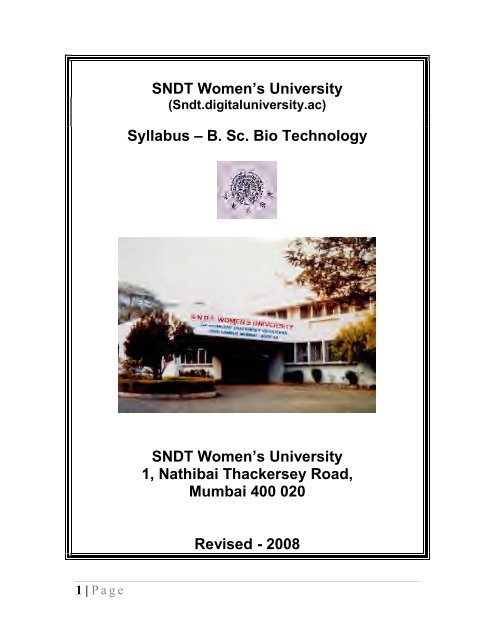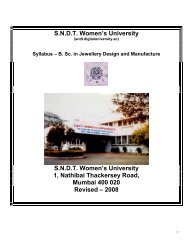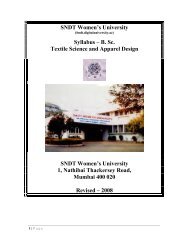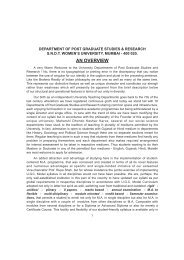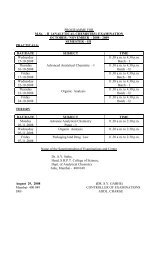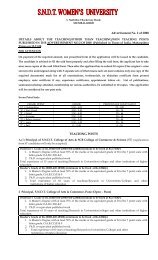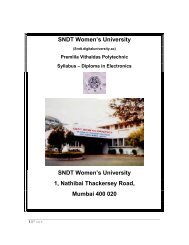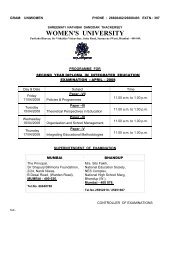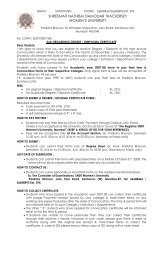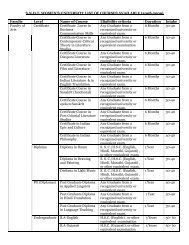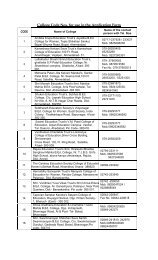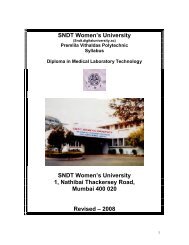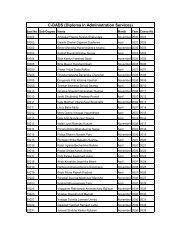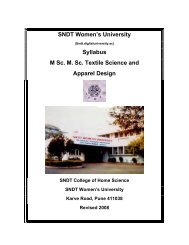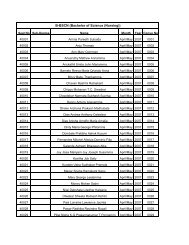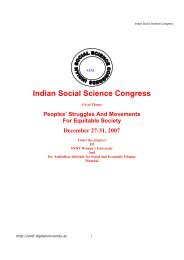SNDT Women's University Syllabus â B. Sc. Bio Technology SNDT ...
SNDT Women's University Syllabus â B. Sc. Bio Technology SNDT ...
SNDT Women's University Syllabus â B. Sc. Bio Technology SNDT ...
You also want an ePaper? Increase the reach of your titles
YUMPU automatically turns print PDFs into web optimized ePapers that Google loves.
<strong>SNDT</strong> Women’s <strong>University</strong><br />
(Sndt.digitaluniversity.ac)<br />
<strong>Syllabus</strong> – B. <strong>Sc</strong>. <strong>Bio</strong> <strong>Technology</strong><br />
<strong>SNDT</strong> Women’s <strong>University</strong><br />
1, Nathibai Thackersey Road,<br />
Mumbai 400 020<br />
Revised - 2008<br />
1 | P a g e
B.<strong>Sc</strong>. BIOTECHNOLOGY<br />
INTRODUCTION - BIOTECHNOLOGY COURSE<br />
<strong>Bio</strong>technology refers to the use of living organisms or the products of these organisms to modify<br />
human health and the human environment. It is revolutionizing the way we manufacture products<br />
and view the relationships of all living things.<br />
Although biotechnology is considered a rather new science, the processes used today have their<br />
basis in nature. These processes are used to transfer genetic materials from one cell into another<br />
by using a common bacterium. This transfer of DNA permits variance of one or several traits and<br />
confers a new property on an organism. For example, tomato plants have been made resistant to<br />
Tobacco Mosalc Virus, which can cause large crop loss.<br />
<strong>Bio</strong>technology has the potential to affect a number of fields and issues, including agriculture, food<br />
processing, health care, forensics, energy production, and the environment. Current applications<br />
include diagnostics, the production of vaccines and pharmaceuticals, and improved crop and<br />
livestock the life sciences such as biotechnology, medicine, biomedical research bioinformatics,<br />
etc.<br />
2 | P a g e
S..D.T. WOME’S UIVERSITY<br />
<strong>Syllabus</strong><br />
(2007-2008)<br />
B.SC. (<strong>Bio</strong>technology)<br />
Semester I to VI<br />
Faculty ame: <strong>Sc</strong>ience<br />
Course ame : B.<strong>Sc</strong>. <strong>Bio</strong>-<strong>Technology</strong><br />
<strong>Sc</strong>heme: SEMESTER I<br />
o. Subject L C P D TP TW P/V T<br />
1001<br />
Introduction to<br />
<strong>Bio</strong>technology and 4 7 6 3 75 25+25 50 175<br />
Cell <strong>Bio</strong>logy<br />
1002<br />
Inorganic, Organic &<br />
Physical Chemistry<br />
4 6 4 3 75 25+25 25 150<br />
1003<br />
General Microbiology<br />
and Basic 4 6 4 3 75 25+25 25 150<br />
<strong>Bio</strong>chemistry<br />
Total 12 19 14 9 225 75+75 100 475<br />
SCHEME: SEMESTER II<br />
o. Subject L C P D TP TW P/V T<br />
2001<br />
FUNDAMENTALS OF<br />
BIOCHEMISTRY,<br />
BIOCOMPUTING AND<br />
BIOSTATISTICS<br />
4 7 6 3 75 25+25 50 175<br />
2002<br />
MICROBIAL<br />
PHYSIOLOGY AD 4 6 4 3 75 25+25 25 150<br />
GEETICS<br />
2003 BIOPHYSICS 4 6 4 3 75 25+25 25 150<br />
Total 12 19 14 9 225 75+75 100 475<br />
SCHEME: SEMESTER III<br />
o. Subject L C P D TP TW P/V T<br />
BASIC ASPECTS OF<br />
3001 CELLULAR<br />
METABOLISM<br />
4 7 6 3 75 25+25 50 175<br />
3002 BIOSTATISTICS 4 6 4 3 75 25+25 25 150<br />
3003 BIOCHEMISTRY 4 6 4 3 75 25+25 25 150<br />
Total 12 19 14 9 225 75+75 100 475<br />
3 | P a g e
SCHEME: SEMESTER IV<br />
o. Subject L C P D TP TW P/V T<br />
4001<br />
FUNDAMENTALS OF<br />
IMMUNOLOGY AND<br />
GENETICS<br />
4 7 6 3 75 25+25 50 175<br />
4002<br />
4003<br />
BIOPHYSICAL AND<br />
BIOCHEMICAL<br />
TECHNIQEUS<br />
4 6 4 3 75 25+25 25 150<br />
ORGAIC AD<br />
BIOPHYSICAL 4 6 4 3 75 25+25 25 150<br />
CHEMISTRY<br />
Total 12 19 14 9 225 75+75 100 475<br />
SCHEME: SEMESTER V<br />
o. Subject L C P D TP TW P/V T<br />
BIOPROCESS AND<br />
5001 BIOCHEMICAL<br />
ENGINEERING<br />
4 7 6 3 75 25+25 50 175<br />
5002<br />
5003<br />
GENETICS AND<br />
MOLECULAR<br />
BIOTECHNOLOGY<br />
4 7 6 3 75 25+25 50 175<br />
ANALYTICAL<br />
TECHNIQUES IN 4 7 6 3 75 25+25 50 175<br />
BIOTECHNOLOGY<br />
Total 12 21 18 9 225 75+75 150 525<br />
SCHEME: SEMESTER VI<br />
o. Subject L C P D TP TW P/V T<br />
6001<br />
PRINCIPLES OF<br />
BIOTECHNOLOGY<br />
APPLIEDTO PLANTS &<br />
4 7 6 3 75 25+25 50 175<br />
ANIMALS<br />
6002<br />
ENVIRONMENTAL<br />
BIOTECHNOLOGY<br />
4 7 6 3 75 25+25 50 175<br />
6003<br />
RELEVANT TOPICS IN<br />
BIOTECHNOLOGY<br />
4 7 6 3 75 25+25 50 175<br />
Total 12 21 18 9 225 75+75 150 525<br />
4 | P a g e
SEMESTER-I<br />
PAPER 1 INTRODUCTION TO BIOTECHNOLOGY AND CELL BIOLOGY<br />
4HRS /WK<br />
Credits: 4 Total Hrs 60 100 Marks<br />
Sr.<br />
No.<br />
Module<br />
I<br />
Sub-topics<br />
1 INTRODUCTION & SCOPE OF BIOTECHNOLOGY<br />
1.1 Historical Perspective<br />
1.2 Definitions of <strong>Bio</strong>technology<br />
1.3 Applications of <strong>Bio</strong>technology- Agriculture,<br />
Medicine & Environment<br />
1.4 Ethical and Social Impacts<br />
1.5 Current Status of <strong>Bio</strong>technology & Future of<br />
<strong>Bio</strong>technology in Developing World.<br />
2 BASIC CONCEPT AND UNDERSTANDING OF CELL<br />
2.1 Concept of Life, Cell As A Basic Unit Of Living<br />
System and Cell Theory<br />
2.2 Origin and Evolution of Cell<br />
2.3 Diversity of Cell Size and Shape<br />
2.4 Classification, Structure and Function of<br />
Prokaryotic cell<br />
2.5 Microscopic Techniques for Study of Cell<br />
3 STRUCTURE AND FUNCTION OF CELL<br />
ORGANELLES<br />
3.1 Cell Wall and Plasma Membrane<br />
3.2 Cytoskeleton<br />
3.3 Mitochondria, Chloroplast, Endoplasmic<br />
Reticulum, Golgi Bodies<br />
3.4 Lysosomes, Glyoxisomes, Peroxisomes,<br />
Ribosomes<br />
3.5 Nucleus<br />
4 CELL CYCLE AND CELL DIVISION<br />
4.1 Overview of Cell Cycle<br />
4.2 Mitosis and Meiosis<br />
4.3 DNA Packaging (Prokaryotic and Eukaryotic)<br />
4.4 Structure and Ultrastructure of Chromosome<br />
4.5 Polytene and Lampbrush Chromosomes<br />
5 ADVANCE STUDIES IN CELL BIOLOGY<br />
5.1 Cell Locomotion- Amoeboid, Flagella, Cillia,<br />
Cytoplasmic Streaming<br />
5.2 Cell- Cell Interaction<br />
5.3 Cellular Basis of Development –<br />
Gametogenesis, Fertilization, Events during<br />
Fertilization, Early Embryonic Development<br />
5.4 Overview of Stem cells<br />
5.5 Cancer <strong>Bio</strong>logy<br />
No of<br />
lectures<br />
10<br />
15<br />
10<br />
15<br />
10<br />
Weightage<br />
in %<br />
20<br />
10<br />
25<br />
20<br />
25<br />
5 | P a g e
INTRODUCTION TO BIOTECHNOLOGY & CELL BIOLOGY (PRACTICALS)<br />
6 HRS/WK<br />
1. Introduction to LAB and lab environment<br />
2. Pipetteman use and calibration<br />
3. Use of top-loading balances, analytical balances and double pan balances<br />
4. Using and writing standard experimental protocols; Flow chart<br />
5. Preparation of solution<br />
6. Preparation of buffer solution<br />
7. Operation of pH meter and measurement of pH<br />
8. Staining techniques (Simple, Differential and Special)<br />
9. Calibration of stage and ocular micrometer and measurement of given biological samples<br />
10. Use of Haemocytometer and determination of cell densities (Blood ells/Yeast)<br />
11. Cytology and histology of various organs ( Permanent slides or fresh preparation)<br />
12. Cell types of plants – maceration of various tissues and identification of Xylem, vessels,<br />
trachied stomata, root hair<br />
13. Preparation of permanent slides showing different stages of cell division – Mitosis and<br />
meiosis<br />
14. Human Karyotyping<br />
Credits: 3 Total Hrs 90 75 Marks<br />
LIST OF REFERENCE BOOKS:<br />
1. Alberts, Molecular <strong>Bio</strong>logy of cell. Garland Pub.<br />
2. Verma, Cell biology, Genetics, Molecular <strong>Bio</strong>logy, Evolution & Ecology. 2006<br />
3. Karp, Cell & Molecular <strong>Bio</strong>logy: concepts & Experiments, 4 th Edition<br />
4. Lodish, Cell & Molecular <strong>Bio</strong>logy, W.H. Freeman, 5 th Edn.<br />
5. Becker, 1996, <strong>Bio</strong>technology: A laboratory course, Alp<br />
6. Glick, Molecular <strong>Bio</strong>technology, ASM publication<br />
7. Becker & Hardin, The world of the Cell, Pearson Pub<br />
8. C.B. Powar, Cell <strong>Bio</strong>logy, Himalaya Press<br />
9. Nelson & Cox, Lehninger Principle <strong>Bio</strong>chemistry,Freeman Pub<br />
10. Desiker, Cell & Development <strong>Bio</strong>logy, Dominant Pub<br />
11. Albert, Essential Cell <strong>Bio</strong>logy, Garland <strong>Sc</strong>ience<br />
12. Geoffrey Cooper, The – Cell Molecular Approach, ASM Pub<br />
13. <strong>Bio</strong>technology, Demystifying the concepts. By David Bourgaize. Alp 2000<br />
14. <strong>Bio</strong>tInquiry- making connections in <strong>Bio</strong>logy, Nancy L.Pruitt, William Surver, John Wlley & Sons<br />
15. Explore Life, postlethwait J.H., & Hopson J.H., Thomson book pub<br />
16. Essential <strong>Bio</strong>logy (3 rd Edition), Campbell, Reece & Simon<br />
17. De Robertis, Cell <strong>Bio</strong>logy<br />
18. <strong>Bio</strong>technology Fundamental & application, S.S. Purohit, Agrobios<br />
19. Analyzing Chromosome, B. Crepulkowaki, BIOS <strong>Sc</strong>ientific Publishers Ltd.<br />
20. Cytogenetics, P.K. Gupta, Rastogi Pub<br />
21. Introduction to <strong>Bio</strong>technoloogy, Brown Campbell priest, Panima Pub<br />
22. Basic <strong>Bio</strong>technology, Prave Fanst, Sitting & Sukatsch, Panma Pub<br />
23. <strong>Bio</strong>technology & Genomics, P.K. Gupta, Rastogi Pub<br />
24. <strong>Bio</strong>technology,l U.Satyanarayan, Books and Allied<br />
25. Cell <strong>Bio</strong>logy, SAdava, Panima Pub<br />
26. Cell & Motecular <strong>Bio</strong>logy, P.K. Gupta, Rastogi Pub.<br />
6 | P a g e
PAPER 1 INORGANIC, ORGANIC & PHYSICAL CHEMISTRY : 4HRS /WK<br />
Credits: 4 Total Hrs 60 100 Marks<br />
Sr.<br />
No.<br />
Module<br />
I<br />
Sub-topics<br />
1 a) Hydrogen : Isotopes of hydrogen –<br />
separation of the isotopes – properties and uses<br />
of heavy hydrogen – position of hydrogen in the<br />
Periodic Table – ortho and para hydrogen –<br />
separation difference in structure and properties<br />
– hydrides – definition – classification –<br />
separation and properties.<br />
b) Oxides: Definition – classification –<br />
properties.<br />
c) Water: Hardness of water – types of<br />
hardness – removal of hardness – industrial<br />
implications of hardness in water – estimation of<br />
hardness by EDTA method (outline only) – units<br />
for hardness of water.<br />
d) Hydrogen Peroxide: Manufacture,<br />
properties, structure and uses of hydrogen<br />
peroxide – estimation of hydrogen peroxide by<br />
permanganimetry – strength of hydrogen<br />
peroxide in volume – strength, normality and<br />
percentage – calculation of strength of these<br />
different terms.<br />
e) Ozone : Manufacture, composition, structure<br />
and properties.<br />
2 a) Detection and estimation of nitrogen and<br />
halogens in organic compounds – empirical<br />
formula – molecular formula – structural formula<br />
– calculation of E.F. and M.F. from percentage<br />
composition.<br />
b) Nature of valency of carbon in organic<br />
compounds – brief outline hybridizations sp 3 , sp 2<br />
and sp with one example for each – tetrahedral<br />
arrangement of valency of carbon. Board –<br />
breaking and bond – forming in organic reactions<br />
– homolytic cleavage – heteroltic cleavage –<br />
reaction intermediates – formation, stability and<br />
reactions of carabonium ion, carbanion and free<br />
radicals.<br />
c) Nucleophilis – Electrophiles, definition, types<br />
and examples – specific reactions involving<br />
these.<br />
No of<br />
lectures<br />
15<br />
15<br />
Weightage<br />
in %<br />
25<br />
25<br />
7 | P a g e<br />
d) Types of reactions – substitution – addition –
elimination – rearrangements and polymerization<br />
– illustration with specific examples.<br />
3 a) Gaseous state, Postulates of Kinetic theory of<br />
gases – derivation of expression for pressure of<br />
gas on the basis of Kinetic theory – deducing the<br />
basic gas laws. Derivation of real gases from<br />
ideal behaviour – reasons for deviation.<br />
Derivation of vander Waals gas equation –<br />
explanation of behaviour of real gases on the<br />
basis of vander Walls gas equation.<br />
b) Average, RMS and most probable velocities<br />
(equations only – no derivation) relationship<br />
between these different velocities. Liquefaction<br />
of gases – critical phenomenon – modern<br />
methods – Joule – Thomson effect – inversion<br />
temperature.<br />
4 a) Structure of atom: Rutherford model of the<br />
atom – defects of Rutherford model, Bohr model,<br />
of an atom – merits and demerits – Sommerfeld<br />
modification – wave theory – de Broglie’s<br />
concept – dual nature – Heisenberg’s uncertainty<br />
principle – difference between orbit and orbital –<br />
shapes of atomic orbitals.<br />
b) Bonding : (i) V.B. Theory: Postulates of<br />
V.B. theory – application to the formation of<br />
simple molecules like H 2 , and He. Overlap of<br />
atomic orbitals – s-s, s-p, and p-p, overlap –<br />
principle of hybridization. (ii) M.O. theory:<br />
Formation of M.Os – bonding and anti-bonding<br />
and non-bonding M.Os – M.O. diagram for H 2 ,<br />
He and F 2 .<br />
15<br />
15<br />
25<br />
25<br />
INORGANIC, ORGANIC & PHYSICAL CHEMISTRY (PRACTICALS)<br />
4HRS /WK<br />
Credits: 3 Total Hrs 60 50 Marks<br />
LABORATORY EXPERIMENTS:<br />
At lest 10 Experiments relevant to above topics to be conducted.<br />
8 | P a g e
PAPER 1<br />
GENERAL MICROBIOLOGY AND BASIC BIOCHEMISTRY (THEORY)<br />
4hrs /wk Credits: 4 Total Hrs 60 100 Marks<br />
Sr.<br />
No.<br />
Module<br />
I<br />
Sub-topics<br />
1 Unit of microbial world: <strong>Sc</strong>ope of<br />
Microbiology, Microbiology and Human Health,<br />
Beneficial and Harmful microbes. Development<br />
of microbiology (contributions of pioneers)<br />
2 Diversity of microbial world: Principle of<br />
Classification, Classification of viruses,<br />
Bacteria (including Cyanobacteria) algae and<br />
Fungi (including yeasts).<br />
3 Methods for studying microorganism:<br />
Origin of microbes, Microscopy, Pure culture<br />
techniques, Sterilization, Aseptic techniques,<br />
Isolation of pure culture, Conditions and media<br />
for growth of microorganisms in the Laboratory<br />
4 <strong>Bio</strong>chemistry of Microbes: Chemical<br />
elements, Structure of atoms, Molecules and<br />
Chemical bonds, Chemical reactions,<br />
Molecules of living systems, pH and pK,<br />
Buffers, Carbohydrates, Lipids, Proteins,<br />
DNA & RNA.<br />
5 Structure of archae prokaryotic and<br />
Eukaryotic cells: Plasma membrane,<br />
Transport across membrane, Cell surface,<br />
Energy transformation.<br />
No of<br />
Lectures<br />
12<br />
12<br />
12<br />
12<br />
12<br />
Weightage<br />
in %<br />
10<br />
10<br />
10<br />
10<br />
10<br />
LIST OF REFERENCE BOOKS:<br />
1. Ronald M. Atlas, Alfred E. Brown, Kenneth W. Dobra, Llonas Miller. (1986). Basic<br />
Experimental Microbiology. Prentice Hall. 316pp.<br />
2. Robert F. Boyd. (1984) General Microbiology. Times Mirror/Mosby College Pub. 22pp.<br />
9 | P a g e
GENERAL MICROBIOLOGY AND BASIC BIOCHEMISTRY (PRACTICALS) 4 hrs/wk<br />
Credits: 3 Total Hrs 60 50 Marks<br />
a) Preparation of culture media: solid/liquid<br />
b) Sterilization techniques.<br />
c) Isolation of single colonies of solid media.<br />
d) Enumeration f bacterial numbers by serial dilution and plating.<br />
e) Simple and differential staining.<br />
f) Determination of antibiotic resistance of bacteria.<br />
LABORATORY EXPERIMENTS:<br />
At lest 10 Experiments relevant to above topics to be conducted.<br />
10 | P a g e
11 | P a g e<br />
Semester – II<br />
FUNDAMENTALS OF BIOCHEMISTRY, BIOCOMPUTING & BIOSTATISTICS (THEORY)<br />
PAPER II -<br />
4HRS/WK<br />
Credits : 4 Total hrs : 60 100 : Marks<br />
Sr.<br />
No.<br />
Module<br />
I<br />
Sub-topics<br />
No of<br />
lectures<br />
Weightage<br />
%<br />
1 Chemistry of Life: An Introduction<br />
12 20<br />
1.1 The Properties of Water<br />
1.2 The Properties of <strong>Bio</strong>molecules<br />
1.3 Chemical Bonds/ Interaction: Ionic, Covalent,<br />
Nonpolar, Polar, Hydrogen Bonds, Hydrophobic<br />
Interactions, Vander Wall’s Attractive Force<br />
1.4 pH, pKa, Acids, Bases and Buffers<br />
1.5 Thermodynamics of <strong>Bio</strong>logical System: The First<br />
Law, The Second Law, The Third Law, Free<br />
Energy, ATP and other High Energy Compounds<br />
2 The Molecules of Life – I<br />
12 20<br />
2.1 Chemistry of Carbohydrates: Functions<br />
and Classifications, Monosaccharides:<br />
Configuration and Conformation, Reactions<br />
of Monosaccharides, Sugar Derivatives<br />
2.2 Disaccharides and Polysaccharides:<br />
Classifications and Function<br />
2.3 Glycoconjugates: Proteoglycans,<br />
Glycoproteins and Glycolipids<br />
2.4 Amino Acids: Structures, General Properties,<br />
Classifications, Nomenclature, Nonstandard<br />
Amino Acid (Amino Acid Derivatives)<br />
2.5 Proteins: An Overview of Four Levels of<br />
Structures s in Proteins, Classifications of<br />
Proteins, Properties of Proteins,<br />
<strong>Bio</strong>logically Important Peptides.<br />
3 The molecules of Life – II<br />
12 20<br />
3.1 Lipids: Classifications of Lipids, Functions of<br />
Lipids, Fatty Acids, Triacylglycerols,<br />
Phospholipids, Steroids<br />
3.2 Basic Understanding of Nucleotides,<br />
Structure and Properties of Nitrogen<br />
Basis, Functions of Nucleotides,<br />
Nucleotide Analogs<br />
3.3 Nucleic Acids: Historical aspects of DNA as<br />
Genetic Material, Semi Conservative Nature of<br />
DNA, Chargaff’s Rule<br />
3.4 Watson and Crick DNA Double Helix Structure,<br />
other Types of DNA Structure, Denaruration<br />
and Renaturation of DNA, Types of RNA<br />
and their Functions, Catalytic RNAs (Ribozymes)<br />
3.5 Vitamins: Classification, Functions, Sources and<br />
Deficiency Disorder<br />
4 <strong>Bio</strong>computing :<br />
4.1 Computer Applications: Structure of computer<br />
(components, peripherals, use, types): the<br />
window screen and parts of window, the control panel<br />
4.2 Creation of a drawing, use of window explorer,<br />
word processor use, spreadsheet use. Database<br />
use, presentation use<br />
12 20
4.3 Internet, email and web authoring: setup of email<br />
address, Concept of domain, understanding<br />
the terms, http, www, URL, book marking web<br />
sites, forwarding and saving web pages.<br />
4.4 Basics of HTML page creation & design using HIML<br />
4.5 Inserting tables<br />
5 BIOSTATISTICS :<br />
5.1 <strong>Sc</strong>ope of <strong>Bio</strong>statistics, Samples and population<br />
concept, Collection of data sampling techniques,<br />
Processing of data, Presentation of data<br />
5.2 Measures of Central tendency- Arithmetic, Harmonic<br />
and Geometric Mean, Mode and Median, their<br />
applications, merits and demerits; Measures of<br />
dispersion- Range, Variance, Standard Deviation<br />
Coefficient of variance, their applications, merits<br />
and demerits.<br />
5.3 Correlation analysis and Regression analysis:<br />
Linear, Bivarieate regression analysis<br />
5.4 Probability and Conditional probability, Theoretical<br />
distributions- Binomial and Poisson Distribution<br />
and their Properties; Normal distribution and its<br />
properties, Skewness and kurtosis<br />
5.5 Significance tests: The meaning of significance,<br />
Hypothesis testing, Student’s T-test, Chi square test<br />
(nonparametric test), Analysis of varianceintroduction<br />
and application in biology, one-way and<br />
two-way ANOVA, Calculation of F-Ratio, least<br />
significant difference.<br />
12 20<br />
12 | P a g e
SEMESTER – II<br />
FUNDAMENTALS OF BIOCHEMISTRY, BIOCOMPUTING AND BIOSTATISTICS (PRACTICAL)<br />
6HRS /WK<br />
1. Qualitative tests for carbohydrates<br />
2. Qualitative tests for Amino acids<br />
3. Titration curve of amino acids and determination of pI,<br />
4. pK1 and pK2<br />
5. Estimation of reducing and non reducing sugars<br />
6. Estimation of amino acids<br />
7. Introduction to Window operating system<br />
8. Overview of window accessories<br />
9. Use and application of Word-2000<br />
10. Excel and Power Point-2000<br />
11. Basics of Internet working<br />
12. Concept of multimedia and web-paging)<br />
13. Arrangement of data in tabulate format<br />
14. <strong>Bio</strong>statistics examples:<br />
a) Calculation of Mean, Standard Deviation and<br />
15. Coefficient of Variance<br />
16. b) Frequency distribution graphs and curves<br />
17. c) Value of confidence limit for the population mean<br />
18. d) Significant test: Student’s t-tst for paired & unpaired<br />
19. data<br />
20. e) Chi-square test<br />
g) Analysis of variance (ANOVA)- Randomized Block<br />
21. Design (RBD)<br />
h) Regression Coefficient and Correlation coefficient<br />
LIST OF REFERENCE BOOKS:<br />
13 | P a g e<br />
Credits: 3 Total Hrs 90 75 Marks<br />
1. Jerrold H Zar, <strong>Bio</strong>statistical analysis, 4 th Edition, Pearson Education<br />
2. P.S.S. Sundar Rao, An Introduction to <strong>Bio</strong>statistics, Eastern Economy Edition.<br />
3. N.Gurumani, An Introduction to <strong>Bio</strong>statistics, 2 nd Edition, MJP Publisher<br />
4. Jiang, Xu & Zhang, Current topics in Computational Molecular <strong>Bio</strong>logy, Ane Books<br />
5. Gary B. Fogel & David Corne, Evolutionary Computation In <strong>Bio</strong>informatics, Morgan, Kaufmann<br />
Publishers<br />
6. Martyn, Theoretical & Experimental DNA Computing, Springer International<br />
7. Saras Publication, <strong>Bio</strong>statistics applications<br />
8. Rajaramsn, Computer oriented Numerical Methods, Pentice Hall India<br />
9. Stallings, Computer Organization & Architecture, Pentice Hall India<br />
10. P.K.Sinha, Computer Fundamentals, 2 nd Edn.<br />
11. Yashvant Kanetkar, Let Us C, 6 th Revised Edn, BPB Publication<br />
12. Greenlaw, Hepp, Fundamentals of the Internet & World Wide Web, McGraw Hill Pub<br />
13. Martyn Amos, Theoretical & Experimental DNA Computing Springer International<br />
14. Wayne W.Daniel, <strong>Bio</strong>statistics: a foundation for analysis in the health science. Wiley Pub<br />
15. Lenhinger, Principles of <strong>Bio</strong>chemistry, Belson & Cox, 4 th Edition<br />
16. Stryer – <strong>Bio</strong>chemistry. W.H.Freeman & Co.<br />
17. Plumner. An introduction to practical <strong>Bio</strong>chemistry,3 rd Edition<br />
18. J.Jayaraman. Lab Manual in <strong>Bio</strong>chemistry<br />
19. Cohn and Stumph. Outline of <strong>Bio</strong>chemisty. Wiley eastern<br />
20. Zube’s <strong>Bio</strong>chemistry, 4 th Edition Macmillan<br />
21. Swtzer and Garrty. Experimental <strong>Bio</strong>chemistry WH Freeman. 2 nd Edition<br />
22. Voet & Voet Donald. 3 rd Edition. Fundamentals of <strong>Bio</strong>chemistry, J/W<br />
23. Hames and Hooper. 2000. Instant notes in <strong>Bio</strong>chemistry. BIOS <strong>Sc</strong>i. Publ.
24. Smith G. 1996. <strong>Bio</strong>technology.Cambeidge Univ. Press<br />
25. Geoffrey Cooper. 2000. The cell with CD-Rom. Sinauer Asso. Incorp.<br />
26. Elliott & Elliot. 3 rd Edition <strong>Bio</strong>chemistry and molecular bilogy<br />
27. Seidman and moore. 200. Basic laboratory methods for biotechnology. Lovgman<br />
28. Boyer. 1999. Concepts in <strong>Bio</strong>chemistry. Thomson<br />
29. A Test book of <strong>Bio</strong>chemistry, A.V.S.S. Rama Rao, UBS Publisher<br />
14 | P a g e
MICROBIAL PHYSIOLOGY AD GEETICS (Theory)<br />
Credits : 4 Total hrs : 60 100 : Marks<br />
6HRS /WK<br />
Sr.<br />
No.<br />
Module<br />
I<br />
Sub-topics<br />
No of<br />
lectures<br />
Weightage<br />
%<br />
1 Bacterial morphology and Ultrastructure: 15 30<br />
Composition, structure and biosynthesis of cell<br />
wall in Gram positive and Gram negative bacteria<br />
Physiology of bacteria growth, phases of growth,<br />
Growth conditions. Differentiation in bacterial<br />
Cells – sporulation, germination. Bacterial cell<br />
division, replication of bacterial chromosome, coordination<br />
of cell division with replication of<br />
chromosome, partitioning of chromosome into<br />
daughter cells.<br />
2 Primary and Secondary metabolism. 10 15<br />
3 Bacterial Plasmids: structure & properties, 10 15<br />
replication, incompatibility, plasmid<br />
amplification.<br />
Bacteriophages: Lytic development cycle – T4;<br />
Lytic & lysogenic development of phage λ; single<br />
standard DNA phages.<br />
Transposition: structure of bacterial transposons<br />
types of bacterial transposons. Mechanism of<br />
antibiotic resistance and spread of antibiotic<br />
resistance.<br />
4 Genetic recombination: requirements,<br />
15 30<br />
molecular basis, genetic analysis of<br />
recombination in bacteria.<br />
Bacterial genetics: concepts of haploid<br />
Genomes, Genetic exchange through coniugation,<br />
Transformation and transduction (generalized<br />
and specialized).<br />
Transformation: Natural transformation,<br />
Competence, DNA uptake, role of natural<br />
Transformation, artificially induced competence,<br />
electroportion.<br />
Conjugation: self transmissible plasmids,<br />
F factor, tra genes, on T,F’ and Hfr strains,<br />
steps in conjugation, chromosome mobilization,<br />
transfer systems in Gram Positive bacterua,<br />
DNA repair and restriction: Types of repairs<br />
Systems, restriction endonuclease, various<br />
types of restriction enzymes, their properties and<br />
uses. Methylation – dependent restriction<br />
enzymes, dam and dcm methylases.<br />
Gene expression: transcription, translation and<br />
Control of expression in microbes.<br />
5 Mutations: spontaneous and induced, base<br />
pair changes, frameshifts, deletions, inversions,<br />
tandem duplications, insertions, useful<br />
phenotypes (auxotrophic, conditional lethal,<br />
10 10<br />
15 | P a g e
esistant), reversion vs. suppression, Ames test.<br />
LIST OF REFERENCE BOOKS<br />
1. Wolfgag K. Joklik (1995). Zinssers Microbiology. Mc Graw-Hill Companies. 1294pp.<br />
2. Stanley R. Maloy, David Freifelder, and John E. Cronan. (1994). Microbial Genetics (2 nd<br />
Ed.) Jones and Bartlett Publishers. 512pp.<br />
3. Larry Snyder and Wendy Champness. (1997). Molecular Genetics of Bacteria.<br />
ASM Press. 672pp.<br />
16 | P a g e
MICROBIAL PHYSIOLOGY AD GEETICS (Practicals)<br />
6HRS /WK<br />
Credits: 3 Total Hrs 90 75 Marks<br />
Module Sub-topics<br />
I<br />
1 Determination of growth phase of E.coli by measure<br />
ment of OD and colony forming units. Relationship<br />
between OD and cfu measurements, measurement<br />
of growth by dry weight and wet weight – Penicillium<br />
spp. Determination of antibiotic resistance by<br />
plating method.<br />
Sr.<br />
No.<br />
No of<br />
lectures<br />
Weightage<br />
%<br />
Isolation of E.coli plasmid DNA by rapid method and<br />
Separation by agarose gel electrophoresis.<br />
Transformation of E.coli: Preparation of competent<br />
cells, determination of viable counts, efficiency of<br />
plasmid transformation.<br />
Infection of E.coli with phage T4, determination of<br />
Phage titre by plating method.<br />
Induction of lac operon: culture of E.coli,<br />
Induction by IPTG, measurement of b-galactosidase<br />
Activity over a time period of 2 hr.<br />
Conjugation in E. coli using plate method.<br />
LIST OF REFERENCE BOOKS<br />
1. Alcamo, I.E. Laboratory Fundamentals of Microbiology. 2001. Jones and Bartlett Publishers.<br />
17 | P a g e
BIOPHYSICS (THEORY)<br />
6HRS /WK<br />
Credits: 4 Total Hrs 60 Marks 100<br />
Sr.<br />
No.<br />
Module<br />
I<br />
Sub-topics<br />
1 a) <strong>Sc</strong>ope and methods: Molecular organization,<br />
different levels. Organisation of proteins –<br />
primary, secondary, tertiary and quaternary<br />
structure.<br />
2 Conformational analysis: Nucleic acids and<br />
their organization in living cells. Interactions of<br />
nucleic acids.<br />
3 Polysaccharides and lipids; biological<br />
membranes.<br />
4 Methods in biophysical analysis: CD, ORD,<br />
fluorescence spectroscopy, raman<br />
spectroscopy, EM, NMR, X-ray diffraction.<br />
No of<br />
lectures<br />
Weightage<br />
%<br />
15 25<br />
15 25<br />
15 25<br />
15 25<br />
LIST OF REFERENCE BOOKS<br />
1. Introduction to protein structure, 1991. Branden & Tooze. Garland Publishing Company.<br />
2. <strong>Bio</strong>chemistry of nucleic acids, 1992. Adams et. al. Chapman & Hall.<br />
3. Crystaliography made crystal clear, 1993, G. Rhodes, Academic press.<br />
4. Principles of physical biochemistry, 1998. Van Holde et. al. Prentice Hall.<br />
BIOPHYSICS (Practicals)<br />
4HRS /WK<br />
Credits: 3 Total Hrs 60 50 Marks<br />
LABORATORY EXPERIMENTS:<br />
At lest 10 Experiments relevant to above topics to be conducted.<br />
18 | P a g e
Semester – III<br />
PAPER III BASIC ASPECTS OF CELLULAR METABOLISM (THEORY) 4HRS/WK<br />
19 | P a g e<br />
Credits: 4 Total Hrs 60 100 Marks<br />
Sr.<br />
No.<br />
Module<br />
I<br />
Sub-topics<br />
No of<br />
lectures<br />
Weightage<br />
%<br />
1 1.1 Basics of bioenergetics; Principles of<br />
12 20<br />
thermodynamics: the 1 st law of thermodynamics,<br />
understanding of state functions- H, E, w, q and<br />
terms exergonic, endergonic reactions systems &<br />
surrounding; units of energy<br />
1.2 The 2 nd law of thermodynamics: Defining the<br />
entropy, spontaneous reaction and disorder, concept<br />
of free energy, free energy and direction of chemical<br />
reaction, nature of equilibrium (keq), law of mass<br />
action.<br />
1.3 Introduction to metabolism and metabolic<br />
pathways, compartmentalization of metabolic<br />
pathways, central and peripheral pathways.<br />
1.4 Enzyme Structure and function: Enzymes are<br />
catalytical molecules; Define catalyst, comparebiocatalyst<br />
and chemical catalyst; Enzymes<br />
nomendature and classification, activation of<br />
energy and trasition state theory, collision and<br />
proximity effect.<br />
1.5 Cofactors: Metal ions and organic molecules,<br />
enzyme catalysis mechanism, Enzyme-substrate<br />
interactions_(ES) formation, Factors affecting<br />
enzyme activity: Enzymes and environmental<br />
conditions, Effect of substrate concentrations<br />
on enzyme reaction, enzyme kinetics, derivations<br />
of Michael’s – Menten constant, Linear<br />
transformation of equation<br />
2 2.1 The 3 – Dimensional nature of protein: the complex 12 20<br />
shapes of proteins allow specificity t substrate or<br />
ligand binding; role of tertiary and /or quartnery<br />
structure of protein to achieve 3- D shape<br />
(conformation and configuration)<br />
2.2 Folding and unfolding of proteins, stabilization<br />
of folded protein, examples of Ribouncleases A<br />
and Chymotrypsin reaction mechanism<br />
2.3 Mechanism of enzyme inhibition<br />
2.4 Regulation of metabolic pathways, allosteric<br />
proteins<br />
2.5 Basics and mechanism of covalent modification<br />
of enzyme<br />
3 3.1 Energy releasing and precursors supply pathways:<br />
Overview Glycolysis. Acetyl CoA formation<br />
(PDH- the multienzyme comples), Overview Citric<br />
Acid Cycle, Precursors available form the pathways<br />
3.2 Oxidation – Reduction (Redox Processes):<br />
Redox reactions in living cells, Redox potential,<br />
Redox potential and its relationship with<br />
concentration and pH, Redox column)<br />
3.3 Electron Transport chain; Electron carriers are<br />
12 20
integral proteins of mitochondrial membrane,<br />
components of ETC.<br />
3.4 Oxidative phosphorylation: Oxidation reduction<br />
of NADH carries 2e- and one proton,<br />
chemiosmotic model, formation of proton<br />
gradient across membrane, entry of protons into<br />
drives phosphorylation of ADP to ATP- ATP<br />
synthase, substrate – level phosphorylation<br />
3.5 Regulation of Glycolysis and citric acid cycle<br />
pathways, anaerobic respiration inyeast,<br />
muscle cells and lactobacillus ( Incomplete<br />
oxidation, fermentation)<br />
4 4.1 Photosynthesis vs. Respiration, structure<br />
of chloroplast, - membrane, Grana, Thylakod<br />
and Chlorophyll pigments, light energy and<br />
absorption spectra of chlorophyll a and b<br />
photo systems II and I. Reaction centre,<br />
ATP and NADPH synthesis<br />
4.2 Dark reaction – CO2 fixation use of ATP and<br />
NADPH from light reaction, The Kelvin Cycle.<br />
4.3 An overview of alternative pathways of<br />
carbohydrate metabolism: Pentose Phosphate<br />
pathway, signifance of the pathway; Gluconeogenesis<br />
and its importance<br />
4.4 Lipid metabolism: Oxidation of lipids vie<br />
B- oxidation; Amino acid metabolism:<br />
Assimilation, Transamination oxidative<br />
decarboxylation and synthesis of amino<br />
acids; GS; GOGAT reaction and their<br />
regulation, urea cycle<br />
4.5 An overview of interrelations among the<br />
pathways, Adenylylated energy charge (AEC)<br />
of a cell and overall regulation (Energy State<br />
of the Cell)<br />
5 5.1 Role of membrane in transportation of molecules<br />
and signal Transduction: membrane structure<br />
and fluids mosaic model.<br />
5.2 Movement of molecule across membrane:<br />
The mechanism of transportation<br />
5.3 Membrane proteins and their role in<br />
transportation and transduction of signals’<br />
domains and micro domains of membrane<br />
proteins an basic understanding<br />
5.4 Signal transduction, cascades: The G-Proteinsmembrane<br />
receptors and detail mechanism of<br />
message transfer and secondary messenger<br />
5.5 Role of hormones as messenger in regulation of<br />
cellular metabolism<br />
12 20<br />
12 20<br />
20 | P a g e
PAPER III<br />
BASIC ASPECTS OF CELLULAR METABOLISM (PRACTICALS) 6HRS/WK<br />
Credits: 4 Total Hrs 60 Marks 100<br />
Sr.<br />
No.<br />
Module Sub-topics<br />
I<br />
1 To demonstrate working operations of<br />
spectrophotometer<br />
2 Use of pH meter<br />
3 Isolation of protein by Ammonium Sulphate<br />
precipitation<br />
method.<br />
4 Assaying of various enzymes (any three)<br />
a) Amylases by KI-12 method<br />
b) Phenol oxidase (Potato)<br />
c) Invertase by GOD/OID and DNSA METHOD<br />
d) Proteolytic enzymes (Trypsin or Pepsin)<br />
e) Lipases (Germinating castor seeds)<br />
f) Phosphatases<br />
g) Glucose oxidase.<br />
5 Estimation protein by Lowry’s and Bradfords’s methods<br />
Assaying Enxyme Reaction Kinetics (Invertase or<br />
Phosphatase)<br />
a) Effect of varying substrate concentration on the<br />
reaction rate, Determination of Vo, Vmax and Km<br />
values<br />
b) Effect of parameters pH and temperature on<br />
enzyme activity.<br />
No of<br />
lectures<br />
Weightage<br />
%<br />
LIST OF REFERENCE BOOKS:<br />
21 | P a g e<br />
1. Boyer, 1999, Concepts in biochemistry, Thomson<br />
2. Pagano, 2000, Principle of biostatistics. Thomson<br />
3. Harmes. <strong>Bio</strong>chemistry, 2 nd Ed. Viva Book<br />
4. Fisher, Chemistry for biologists, Viva Books<br />
5. Turner, Molecular <strong>Bio</strong>logy. Viva Books.<br />
6. Enger. Concepts in biology. Tata McGraw-Hill.<br />
7. Iganacimatha. Basic biotechnology.<br />
8. Mitechell. Introduction to Genetic Algorithms. Prentice-Hall.<br />
9. Das and Mookrijee. Outline of biology.<br />
10. Roy and De. Cell bilogy<br />
11. <strong>Bio</strong>technology, Demystifying the concepts. By David Bourgaize. Alp 2000<br />
12. Peaceniks & Lamb. 1994. How to write about biology. Longman.<br />
13. Eric. S. Grace. <strong>Bio</strong>technology unzipped: Promises and realities.<br />
14. William Bains. <strong>Bio</strong>technology from A to Z<br />
15. Barnum. <strong>Bio</strong>technology: An Introduction. 1999. Brooks Cole Pub. Comp.<br />
16. Weaver. Molecular bilogy. WCB/McGraw-Hill 1999<br />
17. Wilson, & Walker. 1995. Principles and techniques of practical <strong>Bio</strong>chemistry.<br />
18. ambridge Univ. Press.<br />
19. Davidson V.L.& Sittman. 1993. <strong>Bio</strong>chemistry.<br />
20. Boyer. 2001. Modern Experimental bioch. 3/e. Addison<br />
21. Becker. 1996. <strong>Bio</strong>technology: A laboratory course. Alp<br />
22. Lenhinger. Principles of biochemistry<br />
23. Stryer- <strong>Bio</strong>chemistry. W.H.Freeman & Co.
22 | P a g e<br />
24. Plumner. An Introduction to practical <strong>Bio</strong>chemistry.<br />
25. J.Jayraman. Lab Manual in <strong>Bio</strong>chemistry.<br />
26. Cohn and Stumph. Outline of <strong>Bio</strong>chemistry. Wiley eastrn.<br />
27. Zube’s <strong>Bio</strong>chemistry. Macmillan.<br />
28. Blel & Odian. 1999. Organic and <strong>Bio</strong>chemistry<br />
29. Tinoco. Iland others. 1995. Physical chemistry Principles and applications in biological<br />
<strong>Sc</strong>iemnces. Prentice-Hall.<br />
30. Paul H. Teesdale & others. 2001. Essentials of <strong>Bio</strong>logical chemistry. J/W<br />
31. Swetzer and Gauilty 1995. Experimental <strong>Bio</strong>chemistry WH Freeman.<br />
32. Voet Donald. 1999. Fundamentals of <strong>Bio</strong>chemistry, J/W<br />
33. Hames and Hooper. 2000. Instant notes in <strong>Bio</strong>chemistry. bIOS <strong>Sc</strong>i. Pubi.<br />
34. Smith G. 1996. <strong>Bio</strong>technology. Cambeidge Univ. Press.<br />
35. Geoffrey looper. 2000. The cell with CD-Rom. Sinauer Asso. Incorp.<br />
36. Athel Cornish-Bowder. 1999. Basic mathematics for biochemists. OUP.<br />
37. Elliott & Elliott. 2001. <strong>Bio</strong>chemistry and molecular biolgy. OUP.<br />
38. Millar Thomas. (ED). 2000. <strong>Bio</strong>chemistry explained: A practical guide to learning<br />
<strong>Bio</strong>chemistry. Hardwood ACa. Publ.<br />
39. Haynie, D.T. 2001. <strong>Bio</strong>logical thermodynamics Cambridge Uni. Press.<br />
40. Hargreaves and Thmpson (Ed). 1999. <strong>Bio</strong>chemistry of Exercises X. Human Kinetics<br />
Publ.<br />
41. Aldridge, Susan. 1994. <strong>Bio</strong>chemistry: a textbook for A- level biology: Practical Guide.<br />
Cambridge Uni. Press.<br />
42. Seidman and Moore. 2000. Basic laboratory methods for biotechnology. Lovgman.
PAPER III BIOSTATISTICS 4HRS/WK<br />
Credits: 4 Total Hrs 60 100 Marks<br />
Sr.<br />
No.<br />
Module<br />
I<br />
Sub-topics<br />
1 Introduction: definition of statistics: population<br />
and Universe, the sample and population,<br />
statistical Inference; parameter and statistics.<br />
2 Interval Data: construction of a histogram;<br />
Interpretation of histogram, the normal distribution,<br />
the mean mode, median and standard deviation,<br />
representing the normal curve, uncertainties in<br />
estimation of a mean, comparison of means and<br />
variances.<br />
Proportion data: examples of proportion data:<br />
(MPN, sterility testing of medicines, animal<br />
toxicity, therapeutic trial of drugs and vaccines,<br />
animal toxicity, infection and immunization<br />
studies) statistical treatment to proportion data.<br />
Chi-square test, goodness of fit.<br />
Count data: examples of count data (bacterial<br />
cell count, radioactivity count, colony and plaque<br />
counts), statistical treatment to count data:<br />
Poisson distribution, standard error, confidence<br />
limits of counts.<br />
3 Analysis of variance: Analysis of co-variance:<br />
Introduction, procedure and tests, multiple<br />
Comparisons<br />
4 Correlation and regression and line fitting<br />
through graph points; standard curves;<br />
correlation, liner regression (fitting the best<br />
straight line through a series of points) MLR,<br />
multi-colinearity. Standard curves and<br />
interpolation of unknown Y-values.<br />
5 Statistical basis of biological assays:<br />
Response-Dose metameter. Delusion Assays<br />
Direct and indirect assays. Quantal Responses<br />
Probit, logit, LD 50 , ED 50, PD 50 – Standard line<br />
Interpolation assay, parallel line assay ( 4 point,<br />
6 point, assays), slope ratio assay.<br />
No of<br />
lectures<br />
Weightage<br />
%<br />
12 20<br />
12 20<br />
12 20<br />
12 20<br />
12 20<br />
LIST OF REFERENCE BOOKS:<br />
1) Bliss, C.I.K. (1967): Statistics in <strong>Bio</strong>logy, Vol. 1 Mc. Graw Hill, New York.<br />
2) Campbell R.C. (1974): Statistics for <strong>Bio</strong>logists, Cambridge <strong>University</strong> Press, Cambridge.<br />
3) Hewitt, W. (1977): Microbiological Assay. Academic Press, New York.<br />
23 | P a g e
4) Lutz, W. (1967): Statistical Methods as Applied to Immunological data, app. 1163-1206. In<br />
D.M. Weir (Ed/) Hand-book of Experimental Immunology. Blackwell Publications Ltd.,<br />
Oxford.<br />
5) Wardlaw, A.C. (1982): (1) Four Point parallel line assay of penicillin pp. 370-379.<br />
(ii) Microbiological assay of a vitamin-nicotinic acid. Pp214-233, In. S.B. Primrose and<br />
A.C. WAARDLAW (Eds.) Sourcebook of Experiments for the Teaching of Microbiology.<br />
Academic Press, London and New York.<br />
6) Wardlaw, A.C. (1985): Practical Statistics for Experimental <strong>Bio</strong>logists. John Wiley and<br />
Sons., Inc. New ork.<br />
24 | P a g e
PAPER III<br />
BIOCHEMISTRY (THEORY)<br />
4HRS/WK<br />
Sr.<br />
No.<br />
1<br />
2<br />
3<br />
4<br />
5<br />
Module<br />
I<br />
Sub-topics<br />
Credits: 4 Total Hrs 60 100 Marks<br />
Protein and nucleic acid structure and conformation,<br />
allosteric proteins, enzymes structure and kinetics,<br />
biological membrane.<br />
Metabolism, basic concepts, carbohydrate, lipid and<br />
nucleic acid metabolism, photosynthesis.<br />
<strong>Bio</strong>synthesis of macromolecules, lipids hormones,<br />
Aminoacids nucleotides.<br />
DNA transactions, gene concepts, DNA replication<br />
Repair and recombination, protein synthesis, control<br />
of gene expression.<br />
Membrane transport, cell walls, hormone action,<br />
Muscle contraction, clinical applications of<br />
<strong>Bio</strong>chemistry.<br />
No of Weightlectures<br />
age %<br />
12 20<br />
12 20<br />
12 20<br />
12 20<br />
12 20<br />
LIST OF REFERENCE BOOKS:<br />
1. Stryer, (1995). <strong>Bio</strong>chemistry, W.H. Freeman & Co. 1064pp.<br />
BIOCHEMISTRY (PRACTICALS)<br />
4HRS/WK CREDITS: 2 TOTAL HRS 60 50 MARKS<br />
a) Estimation of DNA and RNA by measured of sugar.<br />
b) Estimation of protein.<br />
c) Estimation of blood glucose – glucose oxidase ,method<br />
d) Estimation of serum cholesterol – cholesterol oxidase method.<br />
e) Liver function tests.<br />
f) Estimation of biliubin.<br />
LIST OF REFERENCE BOOKS:<br />
1. F.J. Baker, Bacteriological Techniques<br />
2. Gunasekaran, Introduction to Microbial Techniques.<br />
3. Sadasivam and Manickam. <strong>Bio</strong>chemical Methods.<br />
25 | P a g e
Semester – IV<br />
PAPER IV<br />
FUNDAMENTALS OF IMMUNOLOGY AND GENETICS (THEORY)<br />
4HRS/WK<br />
26 | P a g e<br />
Credits: 4 Total Hrs 60 100 Marks<br />
Sr.<br />
No.<br />
Module<br />
I<br />
Sub-topics<br />
No of<br />
lectures<br />
Weightage<br />
%<br />
1 1.1 Introduction and Historical perspective of<br />
15 20<br />
innate and acquired immunity, characteristics<br />
of the immune response, cells involved in the<br />
acquired immune response, soma clonal selection<br />
theory.<br />
1.2 Elements of innate and acquired immunity:<br />
* Innate immunity, physiological and chemical<br />
barriers, cellular defense, Phagocytosis and<br />
extracellular killing, inflammation, fever<br />
biologically active substances, lymphatic<br />
organs, interrelationship between innate and<br />
acquired immunity<br />
1.3 Antigens: Foreignness, high molecular weight,<br />
chemical complexity, degradability, Haptens<br />
1.4 Antigents: Primary and secondary responses,<br />
Antigenicity and antigen binding site, Epitopes<br />
recognized by B-cells and T-cells, cross reactivity,<br />
Immunogenic adjuvant.<br />
1.5 Antibody structure and function: Structural<br />
features and biological properties of<br />
IgG,IgM,IGA, IgD, IgE, and immunoglobulin super<br />
family, generation of antibody diversity.<br />
2 2.1 Antigen-antibody Interactions: Lattice Hypothesis, 10 20<br />
agglutination and precipitation<br />
2.2 Antigen-antibody interactions: In vivo and In vitro<br />
Interactions between Ag & Ab.<br />
2.3 Major Histocompatibility Complex in mouse and<br />
HLA system in human<br />
2.4 T-Cell generation, activation and differentiation<br />
3 3.1 Cytokines: General properties and functions,<br />
12 20<br />
cytokine receptors.<br />
3.2 Complement System: Activation pathways and<br />
biological activities of complements.<br />
3.3 Dysfunctional Immunity: Immediate and delayed<br />
hypersensitivity<br />
3.4 Dysfunctional Immunity: Autoimmunity and<br />
autoimmune diseases<br />
3.5 Dysfunctional Immunity:Immunodeficiency diseases.<br />
4 4.1 History of Genetics: Concepts and definition, Elements<br />
of heredity and variation<br />
4.2 Mendelian inheritance patterns and laws of heredity<br />
4.3 Linkage and linkage maps<br />
4.4 Varieties of gene expression: multiple alleles, lethal<br />
12 20<br />
genes, pleiotrophic genes, Gene Interactions and<br />
epistatis.<br />
4.5 Chromosome systems and sex linkage.
5 5.1 Non Chromosomal inheritance.<br />
5.2 Mutations and their types.<br />
5.3 Chromosomal alterations & meiotic consequences.<br />
5.4 Human genetics.<br />
5.5 Gene mapping and genome analysis.<br />
12 20<br />
PAPER IV<br />
FUNDAMENTALS OF IMMUNOLOGY AND GENETICS (PRACTICSLS)<br />
6HRS/WK<br />
Credits: 3 Total Hrs 90 75 Marks<br />
Sr.<br />
No.<br />
Module<br />
I<br />
Sub-topics<br />
1 1. Preparation and Identification of different cell types<br />
in peripheral blood: Tltal and Differential count of<br />
blood cells.<br />
2. Aglutination and Precipitation.<br />
a) Blood grouping<br />
b) Widal test<br />
c) SRID test<br />
d) Ouchterlony Double Diffusion test<br />
e) HIV detection rapid test<br />
d) Pregnancy detection rapid test<br />
2 Isolation of Ig from serum<br />
3 Detection of Antigen or Antibody by ELISA test<br />
4 Problem solving of Mendalian Principles.<br />
No of<br />
lectures<br />
Weightage<br />
%<br />
LIST OF REFERENCE BOOKS:<br />
1. Immunology – by IM Roitt, J Brostoff and DK Male (1993) BMP. London,<br />
2. J.Kuby (1991). Immunology _ freeman and company<br />
3. A.K.Abbas A.H.Lichtman J.S. Pober (1994). Cellular and Moiecular immunology- W.B.Saundes<br />
Co.Phladelphia<br />
4. V.R. Muthukkaruppan, S. Baskar and F.Sinigaglia (1986) Hybridoma techniques: A laboratory<br />
Course- Macmillian India Limited<br />
5. V.E. Cells (1994) Cell Bilogy Vol-I Immunology to III- Academic Press.<br />
6. Basic Immunology by Jacqueline Sharon<br />
7. Jan Kay. Introduction to Animal Physiology.Viva Books.<br />
8. Jurd. Animal <strong>Bio</strong>logy. Viva books.<br />
9. Riott. Brostoff and Mal. 1993. Immunology, BMP Lond.<br />
10. Abbas and other. 1994. Cellular and molecular immunology. W.B.Saunders Co.<br />
11. Coleman, Lombard & Sicard. 1993Fundamental of immunology. WCB.<br />
12. Janeway etal. 1999. Immunobiology<br />
13. Todd R.F. 2000. Lecture notes on Immunology.<br />
14. David Wild. 2001. Immunoassay Handbook. Macmillian<br />
15. Fairbanks and Andersen: Genetics, the countinuity of life.<br />
16. Hertwell et.al. :Genetics- From Genes to Genomes<br />
17. Karvita Ahluwalia: Genetics. New Age International P.Ltd.<br />
18. Griffith et.al. : An Introduction to Genetic Analysis<br />
19. Weaver Hedrick: Genetics<br />
27 | P a g e
PAPER IV<br />
BIOPHYSICAL AND BIOCHEMICAL TECHNIQEUS (Theory)<br />
6HRS/WK<br />
28 | P a g e<br />
Credits: 3 Total Hrs 60 75 Marks<br />
Sr.<br />
No.<br />
Module<br />
I<br />
Sub-topics<br />
No of<br />
lectures<br />
Weightage<br />
%<br />
1 Concepts of <strong>Bio</strong>energetics:<br />
10 15<br />
Principles of thermodynamics and their applications<br />
in biochemistry – introduction, thermodynamic<br />
system, thermodynamic state functions, first and<br />
second laws of thermodynamics, concept of free<br />
energy, standard free energy, determination of ∆G<br />
for a reaction, relation between equilibrium<br />
constant and standard free energy change,<br />
biological standard state and standard free energy<br />
change in coupled reactions. <strong>Bio</strong>logical oxidationreduction<br />
reactions – introduction, redox<br />
potentials, relation between standard<br />
reductionpotentials and free energy change<br />
(derivations and numericals included). Highenergy<br />
phosphate compounds – introduction,<br />
phosphate group transfers-free energy of<br />
hydrolysis of ATP and sugar phosphates along<br />
with reasons for high ∆G.<br />
2 Hydrodynamic Methods:<br />
05 15<br />
Sedimentation – sedimentation velocity, preparative<br />
and analytical ultracentrifugation techniques,<br />
determination of molecular weight by hydrodynamic<br />
methods (derivations excluded and numericals<br />
included).<br />
3 Measurement of pH:<br />
05 10<br />
Principles of glass and reference electrodes, types<br />
of electrodes, complications of pH measurement<br />
(determination of molecular weight by hydrodynamic<br />
methods (derivations excluded and numericals<br />
included).<br />
4 Radioisotopic Techniques:<br />
Types of radioisotopes used in <strong>Bio</strong>chemistry, units<br />
of radioactivity measurements, techniques used to<br />
measure radioactivity (gas ionization and<br />
liquid scintillation counting), nuclear emulsions used<br />
in biological studies (pre-mounted, liquid and<br />
stripping), isotopes commonly used in biochemical<br />
studies – 32 P, 35 S, 14 C and 3 H), Autoradiography.<br />
<strong>Bio</strong>logical hazards of radiation and safety measures<br />
In handling radioisotopes. <strong>Bio</strong>logical applications.<br />
05 10
5 Chromatography:<br />
10 15<br />
General principles and applications of –<br />
1. Adsorption chromatography.<br />
2. Ion-exchange chromjatogrphy.<br />
3. Thin-layer chromatography<br />
4. Molecular-sieve chromatography<br />
5. Hydrophobic chromatography.<br />
6. Gas-liquid chromatography<br />
7. HPLC<br />
8. Affinity chromatography<br />
9. Paper chromatography.<br />
6 Electrophoresis<br />
05 10<br />
Basic principles of agarose electrophoresis, PAGE<br />
and SDS-PAGE, Two-dimensional electrophoresis, its<br />
importance. Isoelectrofocussing.<br />
7 Spectroscopic Techniques:<br />
15 15<br />
Beer-Lambert law, light absorption and its<br />
transmittance, determination and application of<br />
extinction coefficient, application of visible and UV<br />
spectroscopic techniques (structure elucidation and<br />
numericals excluded). Principle and application<br />
of NMR, ESR, Mass spectroscopy. Fluorescent and<br />
emission spectroscopy.<br />
8 Immunological Techniques:<br />
Immunodiffusion, immunoelectrophcresis,<br />
Radioimmunoassay, ELISA, immunofluorescence.<br />
05 10<br />
29 | P a g e
PAPER IV<br />
BIOPHYSICAL AND BIOCHEMICAL TECHNIQEUS (Practicals) 6HRS/WK<br />
Credits: 4 Total Hrs 90 Marks: 50<br />
Sr.<br />
No.<br />
1<br />
Module<br />
I<br />
Sub-topics<br />
Preparation of standard buffers and determination<br />
of pH of a solution.<br />
2 Qualitative tests for :<br />
a) Carbohydrates<br />
b) Proteins and amino acids<br />
c) Lipids<br />
3 Determination of saponification value and iodine<br />
number of fats.<br />
4 Estimation of ascorbic acid.<br />
5 Titration curve for amino acids and determination of<br />
pK value.<br />
6 Verification of Beer-Lambert’s law.<br />
7 Estimation of –<br />
i) Carbohydrate by anthrone method.<br />
ii) Blood glucose by the methods<br />
(a) Folin-Wu, (b) Nelson-Somogyi.<br />
8 Estimation of amino acids by ninhydrin method.<br />
9 Isolation and assay of glycogen from rate liver.<br />
10 i) Extraction of total lipids by Folch method<br />
ii) Estimation of food adulterant.<br />
11 Estimation of DNA and RNA.<br />
12 Separation of sugars using paper chromatography.<br />
No of<br />
lectures<br />
Weightage<br />
%<br />
30 | P a g e
PAPER IV<br />
ORGAIC AD BIOPHYSICAL CHEMISTRY<br />
4HRS/WK Credits: 4 Total Hrs 60 Marks: 100<br />
Sr.<br />
No.<br />
Module<br />
I<br />
Sub-topics<br />
1 Organic Chemistry:<br />
Electronic theory of valency, dipole moments.<br />
Electronic displacements in a molecule: Inductive<br />
effect, resonance. The hydrogen bond,<br />
hydrophobic interactions. Atomic and molecular<br />
orbitals. Shapes of biomolecules, hybridization and<br />
tetracovalency of carbon.<br />
No of Weightlectures<br />
age %<br />
30 50<br />
Isomerism: Structural isomerism, Stereoisomerism,<br />
Isomerism (E&Z nomenclature)<br />
Types of organic reactions: Substitution addition,<br />
Elimination, rearrangement, Condensation and<br />
polymerization.<br />
Free radicals in biological systems: Oxygen as a<br />
free radical in the autooxidation of fats. Antioxidants<br />
(Free radical inhibitors in the cell such as vitamin A,<br />
vitamin E, vitamin C, Se etc.)<br />
Mechanism of substitution in the benezene ring:<br />
o-, p- and m-directing groups. The concept of<br />
resonance with reference to benzene derivates.<br />
Direct influence of substituents –electronic<br />
Interpretation.<br />
Stereochemistry: Optical isomerism, optical activity,<br />
Meso-compounds, specific rotation, chirality, chiral<br />
Center, enantiomers, diasteroisomers, D L, R S,<br />
Threo erythro notations, conformation and<br />
Configuration, dihedral angles, conformational<br />
Analysis of ethane, n-butane, cyclohexane, monoand<br />
di-substituted cyclohexane, monosaccharides,<br />
boat and chair forms, eclipsed, gauche and<br />
staggered conformations, axial and equatorial<br />
bonds. Anomers and mutarotation, glycoside,<br />
epimers, glucopyranose, fructopyranose, periodic<br />
acid oxidation of sugars.<br />
Heterocyclic systems occurring in living systems:<br />
Numbering of the ring and properties of pyran,<br />
Furan, thiozole, indole, pyridine, pyrimidine,<br />
Quinine, purine and pteridine.<br />
2 <strong>Bio</strong>physicsl Chemistry:<br />
Thermodynamics studies in chemistry and<br />
31 | P a g e<br />
30 50
<strong>Bio</strong>chemistry: Open, closed and isolated system;<br />
first law of thermodynamics, heat of formation and<br />
heat of reaction; second law of thermodynamics,<br />
molecular basis of entropy, Helmholtz and Gibbs<br />
free energy; third law of thermodynamics and<br />
calculation of entropy; application of the first and<br />
second law of thermodynamics in understanding<br />
energies in living cells, chemical potential,<br />
equilibrium constant.<br />
Types of electrodes, standard electrode potential<br />
and its determination, its relationship with emf,<br />
electron transfer measures.<br />
Phosphate group transfer potentials, coupled<br />
reactions.<br />
Water : Physical properties and structure of water,<br />
Hydrogen bonding, ionization of water, pH scale,<br />
acids-bases, Handerson-Hasselbalch equation,<br />
buffers, ionization behaviour of amino acids and<br />
proteins, titration curve, buffer solutions and their<br />
action.<br />
Radioisotope techniques: Nature of radioactivity,<br />
Properties of α,β and γ-rays, measurement of<br />
radioactivity, use of radioisotopes in research.<br />
In vivo and in vitro labeling techniques, double<br />
labeling, quenching, internal standard,<br />
channel ratio, emulsion counting, radioactive<br />
decay,<br />
autoradiography.<br />
Viscosity: Its measurement, viscosity of<br />
Macromolecules, molecular weights of<br />
<strong>Bio</strong>molecules. Sedimentation of<br />
macromolecules, centrifugation techniques<br />
and<br />
their applications, differential centrifugation,<br />
density gradient and ultracentrifugation<br />
techniques. Subcellular fractionaction.<br />
Electrophoretic techniques: Moving boundary<br />
and zonal electrophoresis, paper and gel<br />
Electrophoresis, isoelectric focusing.<br />
Chromatography: Paper, TLC, Adsorption,<br />
partition, ion-exchange, reverse phase, gel<br />
filtration, affinity, gas chromatography, HPLC<br />
(High Pressure Liquid Chromatography).<br />
32 | P a g e<br />
Spectroscopy: Basic concepts & applications
of X-ray diffraction, NMR, ESR, UV, IR,<br />
fluorescence, Raman, mass spectroscopy in<br />
structure determination of organic and<br />
biomolecules, CD and ORD.<br />
Microscopy: Light, electron (scanning and<br />
transmission), phase contrast, fluorescence<br />
microscopy, freeze-fracture techniques,<br />
specific staining of organelles or marker<br />
enzymes.<br />
ORGAIC AD BIOPHYSICAL CHEMISTRY (PRACTICALS)<br />
4hrs /wk Credits: 3 Total Hrs 60 50 Marks<br />
LABORATORY EXPERIMENTS:<br />
At lest 10 Experiments relevant to above topics to be conducted.<br />
33 | P a g e
Semester – V<br />
PAPER V<br />
BIOPROCESS AND BIOCHEMICAL ENGINEERING (THEORY) 4HRS/WK<br />
Credits: 4 Total Hrs 60 100 Marks<br />
Sr.<br />
No.<br />
Module<br />
I<br />
Sub-topics<br />
No of<br />
lectures<br />
Weightage<br />
%<br />
1 1.1 Selective and enrichment Techniques for isolation 12 20<br />
and screening of biotechnologically useful microorganism<br />
from natural and man-made samples.<br />
1.2 Primary secondary screening<br />
1.3 Strain Improvement: Nature of mutation, mutagenesis,<br />
isolation of mutants<br />
1.4 Strain Improvement: Application of recombinant DNA<br />
technique in strain construction<br />
1.5 Techniques for preservation and storage of cultures.<br />
2 2.1 Fermentor and bioreactor: Design and types 12 20<br />
of various fermentors<br />
2.2 Introduction to Aeration and agitation, oxygen<br />
transfer rate, heat control<br />
2.3 Basic concept of growth and growth kinetics<br />
2.4 Batch, fed-batch and continuous culture operations,<br />
chemostat and turbidostat<br />
2.5 Starter culture, its importance and preparation<br />
3 3.1 Introduction and types of fermentation media 12 20<br />
3.2 Raw materials used in fermentation media<br />
3.3 Media optimization<br />
3.4 Sterilization of media, air and equipments<br />
3.5 Process parameters and measurement techniques:<br />
a) Measurement of temperature, pressure and pH<br />
b) Flow rates of liquid and gases<br />
c) Automation (process computerization)<br />
4 4.1 Overview of downstream processing<br />
12 20<br />
4.2 Extraction and separation techniques;<br />
a) Cell distruption – disintegration<br />
b) Flocculation & Floatation<br />
c) Filtration<br />
d) Centrifugation<br />
e) Distillation<br />
4.3 Enrichment of product by:<br />
a) Thermal process<br />
b) Membrane filtration and dialysis<br />
c) Freeze concentration<br />
d) Chromatographic methods.<br />
4.4 Purification: Crystallization and drying<br />
4.5 <strong>Bio</strong>assay, Quality control procedure & fermentation<br />
economics<br />
5 5.1 An overview of solid state fermentation<br />
12 20<br />
5.2 Fermentation processes of alcohol, organic<br />
acids (Cluconic acid & Citric acid)<br />
5.3 Fermentation processes of amino acids (Lysine),<br />
vitamins (Vit.B12)<br />
5.4 Fermentation processes of antibiotics (penicillin)<br />
5.5 Fermentation processes of SCP. Baker’s yeast,<br />
Food & feed yeast, legume inoculants.<br />
34 | P a g e
BIOPROCESS AND BIOCHEMICAL ENGINEERING (PRACTICALS)<br />
6HRS/WK<br />
Credits: 3 Total Hrs 90 75 Marks<br />
1. Isolation, <strong>Sc</strong>reening and characterization of Lipolytic, Proteolytic, Amylolytic microbes and<br />
Enzymes.<br />
2. <strong>Sc</strong>reening of antibiotic producing microorganisms<br />
3. To demonstrate various techniques of bioassay for antibiofatic and vitamins<br />
4. Optimization of medium parameters for the production of biomass and enzymes (Amylases)<br />
5. Typical fermentation of alcohol, gluconic acid and citric acid<br />
6. Separation and purification of antibiotic from fermented broth<br />
7. Determination of growth phases of microorganisms<br />
LIST OF REFERENCE BOOKS:<br />
1. Mukhopadhyay. Process <strong>Bio</strong>technology Fundamental. Viva book<br />
2. Shuler and kargi, 1992. <strong>Bio</strong>process engineering. Prentice-Hall<br />
3. Bialy & Illis. 1986. <strong>Bio</strong>chemical Eng. Fundaments. McGraw-Hill<br />
4. <strong>Sc</strong>hugel. 1987. <strong>Bio</strong>reaction engineering. J/W<br />
5. Stanbury and Whitaker. Principles of fermentation technology.<br />
6. Sikyta. Methods in Industrial microbiology. Ellis Hardwood Ltd.<br />
7. Krijsman. Product recovery in bioprocess technology<br />
8. T.K. Ghose. BHioprocess computation in biotechnology. Ellis Hardwood. Ltd.<br />
9. Murray Joh. 1997. Microorganism and biotechnology.<br />
10. Demain efal. (ED). 1999. Manual of mdustrial Microbiology and <strong>Bio</strong>technology. Asm Press.<br />
11. <strong>Bio</strong>process Engineering Principles by Doran (D); Academic Prss, 1998<br />
12. Cooney, A.E. Humphrey, Comprehensive <strong>Bio</strong>technology: The principles and Regulation of<br />
<strong>Bio</strong>technology in Industry, Agriculture and Medicine, Vol. 2, Pergamon Press, 1985<br />
13. Doran, <strong>Bio</strong>process Engineering Principles- Academic Press-2001<br />
35 | P a g e
Paper VI GENETICS AND MOLECULAR BIOTECHNOLOGY<br />
Sr.<br />
No.<br />
Module<br />
I<br />
36 | P a g e<br />
4HRS/WK<br />
Credits: 4 Total Hrs 60 100 Marks<br />
Sub-topics<br />
1 <strong>Sc</strong>ope of Genetic Engineering<br />
2 Milestones in Genetic Engineering<br />
Isolation of enzymes, DNA sequencing, synthesis and<br />
mutation, detection and separation, cloning, gene<br />
expression. Cloning and patenting of life forms.<br />
Genetic engineering guidelines.<br />
3 Molecular Tools and Their Applications<br />
Restriction enzymes, modification enzymes, DNA and<br />
RNA markers.<br />
4 Nucleic Acid Purification, Yield Analysis<br />
5 Nucleic Acid Amplification and its Applications.<br />
6 Gene Cloning Vectors<br />
Plasmids, bacteriophages, phagemids, cosmids.<br />
Artificial chromosomes.<br />
7 Restriction Mapping of DNA Fragments and Map<br />
Construction. Nucleic Acid Sequencing.<br />
8 cDNA Synthesis and Cloning.<br />
mRNA enrichment, enrichment, reverse transcription,<br />
DNA primers, linkers, adaptors and their chemical<br />
synthesis, Library construction and screening.<br />
9 Alternative Strategies of Gene Cloning<br />
Cloning interacting genes- Two-and three hybrid<br />
systems, cloning differentially expressed genes.<br />
Nucleic acid microarray arrays.<br />
10 Site-directed Mutagenesis and Protein Engineering<br />
11 How to Study Gene Regulation<br />
DNA transfection, Northern blot, Primer extension, S1<br />
mapping. RNase protection assay, Reporter assays.<br />
12 Expression Strategies for Heterologous Genes<br />
Vector engineering and codon optimiztion, host<br />
engineering. In vitro transcription and translation,<br />
expression in bacteria, expression in Yeast, expression<br />
in insects and insect cells, expression in mammalian<br />
cells, expression in plans.<br />
13 Processing of Recombinant Proteins<br />
Purification and refolding, characterization of<br />
recombinant proteins, stabilization of proteins.<br />
14 Phage Display<br />
15 T-DNA and Transposon Tagging<br />
Role of gene tagging in gene analysis, T-DNA and<br />
transposon tagging, identification and isolation of<br />
genes through T-DNA or transposon.<br />
16 Transgenic and Gene Knockout Technologies<br />
Targeted gene replacement, Chromosome<br />
engineering.<br />
17 Gene Therapy<br />
Vector engineering. Strategies of gene delivery, gene<br />
replacement/augmentation, gene correction, gene<br />
edition, gene regulation and silencing.<br />
No of<br />
lectures<br />
Weightage<br />
in %
GENETICS AND MOLECULAR BIOTECHNOLOGY (PRACTICALS)<br />
6 HRS/WK<br />
Credits: 3 Total Hrs 90 75 Marks<br />
Sr.<br />
No.<br />
Module-<br />
Sub-topics<br />
1 Bacterial culture and antibiotic selection<br />
media. Preparation of competent cells.<br />
2<br />
Isolation of plasmid DNA.<br />
3<br />
4<br />
ISOLATION OF Lambda phage DNA.<br />
Quantitation of nucleic acids.<br />
5 Agarose gel electrophoresis and restriction<br />
mapping of DNA.<br />
6 Construction of restriction map of plasmid<br />
DNA<br />
7<br />
Cloning in plasmid/phagemid vectors.<br />
No of<br />
lectures<br />
Weightage<br />
in %<br />
8<br />
Preparation of helper phage and its titration.<br />
9 Preparation of single stranded DNA<br />
template.<br />
10<br />
DNA sequencing.<br />
11 Gene expression in E. coli and analysis of<br />
gene product.<br />
12<br />
PCR<br />
13<br />
Reporter Gene assay (Gus/CAT/b-GAL)<br />
LIST OF REFERENCE BOOKS:<br />
1. Molecular Cloning: a Laboratory Manual, J. Sambrook, E.F. Fritsch and<br />
T. Maniatis, Cold Spring Harbor Laboratory Pres, New York, 2000<br />
2. DNA Cloning: a Practical Approach, D.M. Glover and B.D. Hames, IRL<br />
Press, Oxford. 1995.<br />
3. Molecular and Cellular Methods in <strong>Bio</strong>logy and Medicine, P.B.<br />
Kaufman, W. Wu, D. Kim and L.J. Cseke, CRC Press, Florida, 1995.<br />
4. Methods in Enzymology Vol. 152, Guide to Molecular Cloning Techniques, S.L.<br />
Berger and A.R. Kimmel, Academic Press, Inc. San Diego, 1998.<br />
5. Methods in EnzymologyVol. 185, Gene Expression <strong>Technology</strong>, D.V. Goeddel,<br />
Academic Press, Inc. San Diego 1990.<br />
6. DNA <strong>Sc</strong>ience, A First Course in Recombinant <strong>Technology</strong>, D.A. Mickloss and G.A.<br />
Freyer, Cold Spring Harbor Laboratory Press, New York, 1990.<br />
7. Molecular <strong>Bio</strong>technology (2 nd Edn.), S.B. Primrose, Blackwell <strong>Sc</strong>ientific Publishers,<br />
Oxford, 1994.<br />
37 | P a g e
8. Milestones in <strong>Bio</strong>technology. Classic papers on Genetic Engineering, J.A. Davies<br />
and W.S. Reznikoff, Butterworth-Heinemann, Boston, 1992.<br />
9. Route Maps in Gene <strong>Technology</strong>, M.R. Walker and R. Rapley,<br />
Blackwell <strong>Sc</strong>ience Ltd., Oxford, 1997.<br />
10. Genetic Engineering. An introduction to gene analysis and exploitation in<br />
eukaryotes, S.M. Kingsman and A.J. Kingsman, Blackwell <strong>Sc</strong>ientific Publications,<br />
Oxford, 1998.<br />
11. Molecular <strong>Bio</strong>technology - Glick<br />
38 | P a g e
SEMESTER - V<br />
PAPER VII ANALYTICAL TECHNIQUES IN BIOTECHNOLOGY (THEORY) 4 HRS/WK<br />
39 | P a g e<br />
Credits: 4 Total Hrs 60 100 Marks<br />
Sr.<br />
No.<br />
Module<br />
I<br />
Sub-topics<br />
No of<br />
lectures<br />
Weightage<br />
%<br />
1 Strategies and principles of analytical techniques 10 20<br />
1.1 Concepts of Good Laboratory Practice and Quality<br />
Management<br />
1.2 Qualitative and quantitative aspects of analyzing<br />
resources and products<br />
1.3 Principles and physical cad chemical analysis<br />
1.4 Advancement in development of techniques<br />
1.5 Basics of modern molecular analytical methods in<br />
<strong>Bio</strong>technology<br />
2 Spectroscopy<br />
25 20<br />
2.1 Interaction of EM radiation with matter: Overview of<br />
Electromagnetic spectrum; physical phenomenon:<br />
Absorption, Resonance fluorescence, Emission,<br />
Refraction, Diffraction.<br />
2.2 <strong>Sc</strong>attering, Raman <strong>Sc</strong>attering, Resonance Raman<br />
<strong>Sc</strong>attering, Beer-Lambert’s Laws<br />
2.3 UV-Vis spectrophotometric: The basic modules and<br />
components and their function; instruments based on<br />
spectrophotometer principles:<br />
2.4 Micro plate readers and their applications<br />
2.5 Atomic spectroscopy: Principles and application of<br />
Atomic Absorption/ Emission Spectrometer.<br />
3 3.1 Basics of IR and NMR and their application in<br />
25 20<br />
biotechnology.<br />
3.2 Basics of X-Ray diffraction analysis and their<br />
application in biotechnology<br />
3.3 Overview of separation techniques, Distillation,<br />
Crystallization, Extraction, Ultra filtration, and<br />
dialysis, centrifugation, chromatography &<br />
electrophoresis.<br />
3.4 Centrifugation: Fundamentals and definition, concept<br />
sedimentation, the basis components: Electric motor,<br />
Drive shaft, Rotors to hold tubes and controls;<br />
sedimenting force, RCF, Floating force,<br />
Frictional resistance diffusion and Seder unit;<br />
3.5 Preparative & analytical centrifuges; density gradient<br />
centrifugation (zonal and isopycnic), differential<br />
centrifugation, Application to cell fractionation and<br />
macromolecules.<br />
4 Separation Techniques: Principles and Application :<br />
4.1 Chromatography<br />
a. Chromatography theory and principles:<br />
b. Solvent extraction theory<br />
c. Partition theory: Retention and differential<br />
migration mechanism (Impelling retarding forces) &<br />
equilibrium between two phases, definition of key<br />
terms:retention time, peak shape, band broadening,<br />
column efficiency, Rate Theory (HETP), resolution,<br />
selectivity, normal chromatography & Reverse.<br />
20 20
4.2 Properties of solvents (MP), stationary<br />
phase and supporting phase.<br />
Classifications of the technique, Types: Partition,<br />
Adsorption, Ion exchange, size exclusion,<br />
Affinity, Chromatography. Planner Chromatography,<br />
Paper Chromatography, ILC, Column Chromatography:<br />
CG/ CLC, HPLC and FPLC<br />
Electrophoresis: Principles and methods.<br />
5 5.1 Immunoassay techniques: Antibodies as specific<br />
reagents, Competitive and non-competitive binding<br />
immunoassay, Labeling, ELISA<br />
5.2 <strong>Bio</strong>sensors: Principles and definition, characteristic<br />
of ideal biosensors, Basic measuring procedure<br />
5.3 <strong>Bio</strong>chemical components of biosensors: Enzyme<br />
based biocatalyst sensors, <strong>Bio</strong>affinity systems,<br />
immunosensors<br />
5.4 <strong>Technology</strong> of biosnsors: Immobilization of<br />
bimolecular, activation of inorganic supports,<br />
methods of covalent binding.<br />
5.5 Application of biosensors: Clinical laboratory,<br />
In vivo determination of metabolites, Environmental<br />
monitoring of toxic compounds<br />
20 20<br />
40 | P a g e
ANALYTICAL TECHNIQUES IN BIOTECHNOLOGY (PRACTICALS)<br />
6 HRS/WK<br />
CREDITS: 3 TOTAL HRS 90 75 MARKS<br />
Sr.<br />
No.<br />
Module<br />
I<br />
Sub-topics<br />
1 Introduction to equality use concepts of accuracy and<br />
precision. Selection of analytical procedures. Sampling<br />
and sample preparation. Analysis, reporting and<br />
interpretation, and drawing conclusion. Calibration<br />
and graphical methods. ISO 9000<br />
2 Electricity: Voltage, current, resistance, AC/DC, solve<br />
problems using V=IR, Draw a complete circuit diagram<br />
(e.g. pH meter and spectrophotometer), list of safety<br />
rules for working with electricity.<br />
3 Computer component of given percentage solution,<br />
molarity solution, PPN, PPB solution, and stock solution.<br />
4 pH meter:<br />
a) List uses of pH meter, measurement,<br />
detailed diagram of pH electrod and reference<br />
electrode (combined electrd also), find pH<br />
of a solution giving detailed account of pH<br />
meter operation, troubleshooting.<br />
b) Preparation of solution using pH meter.<br />
c) Demonstration of the effects of the solution.<br />
No of<br />
lectures<br />
Weightage<br />
%<br />
5 Spectroscopy:-<br />
1. The basis component of photometer showing<br />
block diagram.<br />
2. Demonstrate the relationship between the<br />
colored sample solution and the color of<br />
wavelength used (complimentary color)<br />
3. Demonstrate the Beer’s Law, solving problems<br />
using the Law.<br />
4. Preparation of standard curve.<br />
LIST OF REFERENCE BOOKS:<br />
1. Harmes, <strong>Bio</strong>chemistry. 2 nd Ed. Viva Book.<br />
2. Fisher. Chemistry for biologists. Viva Books<br />
3. Wilson, & Walker. 1995. Principles and techniques of practical <strong>Bio</strong>chemistry. Cambridge Univ.<br />
Press.<br />
4. Davidson V.L.& Sittman. 1993. <strong>Bio</strong>chemistry.<br />
5. Blood & other 1996. Laboratory DNA <strong>Sc</strong>ience. Benjamin.<br />
6. Boyer. 2001. Modern Experimental bioch. 3/e. Addison<br />
7. Becker. 1996. <strong>Bio</strong>technology: A laboratory course. ALP<br />
8. Plumber. An introduction to practical <strong>Bio</strong>chemistry.<br />
9. J.Jayraman. Lab Manual in <strong>Bio</strong>chemistry.<br />
10. Chirikjian, J.P. 1995. <strong>Bio</strong>technology Theory and Technique for undergraduate laboratories Vol.1<br />
Jones and Barlett Pub.<br />
11. Tinoco. Iand others. 1995. Physical Chemistry Principles and application in <strong>Bio</strong>logical <strong>Sc</strong>iemnces.<br />
Prentice-Hall<br />
12. Paul H. Teesdale & others 2001. Essentials of <strong>Bio</strong>logical Chemistry.J/W<br />
13. Switzer and Gauity. 1995. Experimental <strong>Bio</strong>chemistry WH Freeman.<br />
41 | P a g e
14. Voet Donald. 1999. Fundamentals of <strong>Bio</strong>chemistry, J/W/<br />
15. Athel Cornish-Vowder. 1999. Basic mathematics for biochemists. OUP.<br />
16. Elliott & Elliott. 2001. <strong>Bio</strong>chemistry and molecular bilogy. OUP<br />
17. Millar Thomas.(ED). 2000. <strong>Bio</strong>chemistry explained: A practical guide to learning <strong>Bio</strong>chemistry,<br />
Hardwood Aca. Publ.<br />
18. Haynie, D.T. 2001. <strong>Bio</strong>logical thermodynamics Cambridge Univ. Press.<br />
19. Hargreaves and Thmpson (Ed). 1999. <strong>Bio</strong>chemistry of Exercises X. Human Kinetics Publi.<br />
20. Aldridge, Susan 1994. <strong>Bio</strong>chemistry: a textbook for A- level biology: Practical Guide. Cambridge<br />
Univ. Press<br />
21. 21 Seidman and Moore. 200. Basic laboratory methods for biotechnology. Lovgman.<br />
42 | P a g e
Semester – VI<br />
PAPER VII PRINCIPLES OF BIOTECHNOLOGY APPLIEDTO PLANTS & ANIMALS (THEORY)<br />
4 HRS/WK<br />
Credits: 4 Total Hrs 60 100 Marks<br />
Sr.<br />
No.<br />
Module Sub-topics No of<br />
lectures<br />
Weightage<br />
%<br />
1 1.1 Principles of tissue culture: Historical perspectives 12 20<br />
and development of plant/animal tissue culture<br />
techniques.<br />
1.2 Cell/tissue growth and differentiation- morphogenesis<br />
1.3 Concepts of totipotency of cell<br />
1.4 The tissue categories and key characteristics of<br />
animal tissues<br />
1.5 Concepts embryonic and stem cell<br />
2 2.1 Laboratory requirements for tissue culture<br />
12 20<br />
2.2 Culture media: preparation/ constituents and<br />
concepts of sterilization<br />
2.3 Preparation, isolation and selection of explant<br />
2.4 Nonconventional bloreactors<br />
2.5 Liquid cell suspension culture : Pollen cultue and<br />
protoplast culture, production and uses of<br />
haploids, preservation techniques of germplasm<br />
3 3.1 Gene transfer techniques using Agrobacterium 12 20<br />
3.2 DNA mediated gene transfer, basics of GMO<br />
3.3 Transgenic plants- crop improvement<br />
(viral resistance insect resistance, microbial<br />
resistance,herbicide tolerance & stress resistance)<br />
3.4 Plant tissue culture and secondary<br />
metabolite production<br />
4 4.1 Laboratory facilities, culture media and procedure 12 20<br />
for animal, cell and tissue culture<br />
4.2 Primary cultures, cell lines and cloning<br />
4.3 Tissue and organ culture<br />
4.4 In vitro fertilization and embryo transfer<br />
4.5 Transfection methods<br />
5 5.1 Hybridoma and monoclonal antibodies<br />
12 20<br />
5.2 Vaccine production by animal tissue culture<br />
5.3 Transgenic animals: Mice, Fish and Ship<br />
5.4 Production of synthetic seeds<br />
5.5 Edible vaccines and BT cotton.<br />
43 | P a g e
44 | P a g e
PAPER VIII<br />
PRINCIPLES OF BIOTECHNOLOGY APPLIED TO PLANTS & ANIMALS (PRACTICALS)<br />
6 HRS/WK<br />
CREDITS: 3 TOTAL HRS 90 75 MARKS<br />
1. Sterilization and related techniques used in tissue culture<br />
a) Autoclaving<br />
b) Hot Air Oven<br />
c) Filter Sterilization<br />
d) surface sterilization<br />
e) demonstration of all techniques related to sterilization,<br />
2. transfer and uses of Laminar Air Flow Hood and UV.<br />
3. Preparation of Media and media composition<br />
4. Introduction of explant for callusing<br />
5. Characterization of Callus<br />
6. Sub culturing of Callus<br />
7. Isolation of protoplasts<br />
8. Establishment of primary cell lines<br />
9. Isolation of Chick embryo<br />
10. Embryo transfer method<br />
LIST OF REFERENCE BOOKS:<br />
1. Enger, Concepts in biology, Tata McGraw-Hill.<br />
2. Iganacimatha. Basic biotechnology<br />
3. Das and Mookerjee. Outline of biology<br />
4. Roy and De.cell bilogy<br />
5. <strong>Bio</strong>technology, Demystifying the concepts. By David Bourgaize. Alp2000<br />
6. Eric. S. Grace. <strong>Bio</strong>technology uzippe: Promises and realities.<br />
7. William Bains. <strong>Bio</strong>technology from A to Z<br />
8. Barnum. <strong>Bio</strong>technology: An Introduction 1999. Brooks cole Pub. Co.<br />
9. Becker. 1996. <strong>Bio</strong>technology: A laboratory course.Alp<br />
10. Cohn and Stumph. Outline of <strong>Bio</strong>chemistry. Wiley eastern.<br />
11. Miglani. Dictionary of plant genetics and molecular biology. Viva Books<br />
12. Jan kay. Introduction to Animal physiology. Viva Books<br />
13. Jurd. Animal <strong>Bio</strong>logy. Viva books<br />
14. Twyman. Developmental <strong>Bio</strong>logy. Viva Books<br />
15. Iganacimatha. Appl. Plant <strong>Bio</strong>technology<br />
16. K.K.De. Plant tissue culture<br />
17. Babinnk and Philips. 1989. Animal <strong>Bio</strong>technology. Pergamonn.<br />
18. Gibert, Developmental biology<br />
19. Radint and Bhojwani. Plant and tissue culture<br />
20. Dixon and Gonzales. Plant cell culture. A practical approach. IRL press.<br />
21. Jenkius N. 1999. Animal cell biotechnology. Methods and protocols. Humana pres.<br />
22. Butler and Walter. 1997. Animal cell cultures and technology: The basics. IRL press<br />
23. VErpoorte, R. (ed). 2000. Metabolic engineering of plant secondary metabolism.<br />
24. Masters JRW (ED). Animal cell culture: A practical approach. 2000. OUP.<br />
25. Elements of <strong>Bio</strong>technology: P.K. Gupta<br />
45 | P a g e
26. Methods in plant tissue culture : U. Kumar<br />
27. Molecular biotechnology: Bernard, R. Glick and Pasternak<br />
28. Animal cell culture: Morgan<br />
29. Cell culture: butler and Dawson<br />
46 | P a g e
PAPER IX ENVIRONMENTAL BIOTECHNOLOGY (THEORY) 4 HRS/WK<br />
Sr.<br />
No.<br />
Credits: 4 Total Hrs 60 100 Marks<br />
Module Sub-topics No of lectures Weightage<br />
%<br />
1 1.1 Understanding the Earth Environment<br />
1.2 Basic concept of ecology and ecosystem; the<br />
components and processes of an ecosystem flow<br />
of energy and matter, food chain<br />
1.3 <strong>Bio</strong>geochemical cycle; their role in functioning of<br />
an ecosystem<br />
1.4 <strong>Bio</strong>diversity and biotechnology, Conservation of<br />
natural resources<br />
1.5 Interaction within, between and among population<br />
in community<br />
2 2.1 Microbes and their habitats<br />
2.2 Diversity in metabolic processes among<br />
microorganism<br />
2.3 Metabolism of organic matter<br />
2.4 Respiration, oxygenation, nitrate respiration,<br />
sulfate respiration, lithotrophy, hydrogen<br />
bacteria and sulfur bacteria, phototropic bacteria<br />
2.5 <strong>Bio</strong>degradation: Definition- ready<br />
biodegradability, ultimate biodegradation,<br />
inherent biodegradability, recalcitrant compounds,<br />
Anthropogenic compounds (Zenobiotics)<br />
3 3.1 An overview of selected compounds:<br />
Petroleum hydrocarbons, Alkanes,<br />
cycloalkanes, Aromatics, polycyclic,<br />
aromatics xenobiotics the pesticides.<br />
3.2 Pollution and contamination of natural<br />
components of environment :<br />
Define pollution and contamination; sources<br />
of pollutants, Transport and fate of contaminants<br />
in the environment<br />
3.3 Isolation and screening microbes degrade<br />
contaminants (pollutants):<br />
selective and enrichment cultivation techniques<br />
3.4 Transformation of pesticides- DDT (Dechlorination)<br />
to DBP and biomagnifications, reductive<br />
dechlorination of PCE, TCE and petroleum<br />
hydrocarbons.<br />
3.5 Concept of Co-oxidation and co-metabolism.<br />
Oxidative and reductive pathways of<br />
nitrobenzene biodegradation by Pseudomonas<br />
4 4.1 Treatment <strong>Technology</strong> of domestic wastewater:<br />
Physical, chemical and biological properties<br />
of wastewater primary, secondary and tertiary<br />
treatment processes, emphasizing on various<br />
biological oxidation processes and advanced<br />
treatment processes<br />
4.2 Activated sludge and anaerobic digestion<br />
4.3 Treatment of air pollutants using biotechnological<br />
procedure; basis of <strong>Bio</strong>leaching<br />
4.4 An overview of process of bioremediation<br />
4.5 Mechanism of composting<br />
12 20<br />
12 20<br />
12 20<br />
12 20<br />
47 | P a g e
5 5.1 Agricultural <strong>Bio</strong>technology: Basic of <strong>Bio</strong>logical<br />
Nitrogen Fixation and its importance<br />
5.2 Microbial processes of nitrification and<br />
defitrification; blotechnological applications in<br />
wastewater treatment and soil quality improvement.<br />
5.3 <strong>Bio</strong>control and biotechnology<br />
5.4 <strong>Bio</strong>fertilizer and bioplastic<br />
12 20<br />
48 | P a g e
ENVIRONMENTAL BIOTECHNOLOGY (PRACTICALS)<br />
6 HRS/WK<br />
1. Isolation of microorganisms from contaminated<br />
2. sources (water, soil) and screening for their<br />
3. potential to degrade xenobiotic<br />
4. Analysis of waste water<br />
CREDITS: 3 TOTAL HRS 90 75 MARKS<br />
1. To study sampling techniques, sample preservation<br />
2. To visit local sewage treatment plant to study its<br />
5. design, operation of primary, secondary , tertiary<br />
6. systems and mode of disposal<br />
3. To collect grab and composite sample<br />
4. Analysis of physical-Chemical parameters:<br />
7. TS,TDS, Colur, Tubidigy, pH,DO,COD, BOD,<br />
8. Total- N, PO4-p, NO3-N, NO2-N,NH4-4, chloride,<br />
9. Ca-Mg-hardness.<br />
5. Bacteriological analysis by MNP technique<br />
10. Isolation of nitrogen fixers from soil<br />
11. To determine MNP of Nitrifying organisms from soil<br />
12. To determine MNP of endospore formers.<br />
LIST OF REFERENCE BOOKS:<br />
1. Hammer. Water and Wastewater technology. Prentice-Hall<br />
2. APHA. Water and Wastewater analysis.<br />
3. <strong>Sc</strong>ragg. A.H.1999. Envion. <strong>Bio</strong>technology. Longman<br />
4. Rittman & Mc Carthy. 2000. Environ. <strong>Bio</strong>technology. Principles and application. McGraw-Hill.<br />
5. N.P. Cheremisinoff. 1999. <strong>Bio</strong>technology for waste and wastewater treatment. Noyes Pub<br />
6. Micheal Heal. (Ed).2001. Environmental monitoring and biodiagnostics of hazardous<br />
Contaminants.<br />
7. Milton. Wainwright. 1999. An Introduction to Environ. <strong>Bio</strong>technology. Kluwer Acad.<br />
8. Mitchell Melanie. 1998. An introduction to genetic algorithms. The MIT Press.<br />
9. Boyle Mike. 2000. Genes and genetic engineering AQA (B) <strong>Bio</strong>logy. Collins Educa<br />
10. Alan Fersht. 1999. Structure and mechanism in protein science. WH Freeman . Enggins Brian.<br />
1997. <strong>Bio</strong>ssensors. J/W<br />
11. Cunningham, A Introduction to <strong>Bio</strong>analytical Sensers J/W. 1998.<br />
49 | P a g e
PAPER – X RELEVANT TOPICS IN BIOTECHNOLOGY (THEORY) 4 HRS/WK<br />
Credits: 4 Total Hrs 60 100 Marks<br />
Sr.<br />
No.<br />
Module Sub-topics<br />
No of<br />
lectures<br />
Weightage<br />
%<br />
1 Principles of radiation biology<br />
12 20<br />
1.1 Atom, Nuclei, and radiation and radioactivity,<br />
radiation decay<br />
1.2 Natural and man-made sources of radioactivity,<br />
units and measurement of radioactivity.<br />
1.3 Radioactive substance, Radioisotopes, and<br />
their application<br />
1.4 Ionizing radiation, free radicals and radiation<br />
biology, health hazards<br />
1.5 Radiation and cancer bilogy.<br />
2 Understanding evolutions<br />
12 20<br />
2.1 Origin of life: Primitive earth and present earth<br />
environment and its development<br />
2.2 Early life processes of formation of the present<br />
complex life forms<br />
2.3 Theories of origin of organic evolution; Charles<br />
Darwin, Lamark and Wallace, Definition of<br />
biological evolution, micro and macroevolution<br />
2.4 Understanding species, morphological and<br />
biological species concept, theory of natural<br />
selection.<br />
2.5 Types of reproductive isolation and species<br />
formation, allopathic, sympatric and paratactic<br />
speciation<br />
3 Immobilization techniques and bioinformatics<br />
12 20<br />
3.1 Immobilization of cell and enzyme: Basic<br />
concept of immobilization in biotechnology,<br />
principles and mechanism of immobilization,<br />
techniques adsorption, occlusion, cross-linking,<br />
convalent binding, and Ionic binding.<br />
3.2 Choice of immobilization methods, choice of<br />
reactors, properties of immobilized enzyme –<br />
stability and kinetic properties.<br />
3.3 Supporting matrices used and their properties.<br />
Examples of the techniques in biotechnology:<br />
Alcohol, semi synthetic antibiotics, and amino<br />
acids production<br />
3.4 <strong>Bio</strong>technology and bioinformatics: What is<br />
bioinformatics Need of bioinformatics in<br />
biotechnology- an overview of bioinformatics<br />
3.5 <strong>Bio</strong>technology, biodiversity and bioinformatics:<br />
Genome and genome analysis.<br />
4 <strong>Bio</strong>informatics<br />
4.1 History of Human Gemone project (HUGP)<br />
4.2 Present status of human genome<br />
4.3 <strong>Bio</strong>informatics, Pharma and forme: Crop genomic,<br />
Gene finding, comparative Genomic, Bacterial<br />
analysis, Gene function discovery and chip informatics<br />
4.4 Introduction to DNA/Protein searching, the main<br />
databases use<br />
4.5 <strong>Bio</strong>informatics and molecular terms XML, Browser<br />
and databse, BIOXML, GAME, BSML, DTD, BLST,<br />
FASTA, GDB, Expasy, SWISS PORT, PDB.<br />
Gen Bank, EMBL, NCBI<br />
12 20<br />
50 | P a g e
5 Assignment<br />
Topics of assignment may be decided by the<br />
students relating to the subject and be submitted<br />
and examined during practical examination<br />
12 20<br />
51 | P a g e
BIOTECHNOLOGY (Practicals)<br />
6 HRS/WK<br />
CREDITS: 3 TOTAL HRS : 90 75 MARKS<br />
a) Preparation of culture of yeast cells and A. niger<br />
b) for cell imoblization and enzyme immobilization.<br />
c) Gel entrapment of yeast cells and to determine invertase<br />
d) activity by the Immobilized cells<br />
e) Immobilization of enzyme (glucose oxidase) from<br />
f) A-niger and measurement its activity<br />
g) To visit local cancer hospital to understand the working<br />
h) principles of radiation therapy and to prepare a report<br />
i) To demonstrate the radiation (X-ray, UV rays,) induced<br />
j) mutation in bacteria and searching for mutant<br />
k) Demonstration of various domains (search engines)<br />
l) for bioinformatics through internet.<br />
LIST OF REFERENCE BOOKS:<br />
1. Enger. Concepts in biology, Tata McGraw-Hill<br />
2. Iganacimatha, Basic <strong>Bio</strong>technology<br />
3. Das and Mookerijee. Outline of biology<br />
4. Roy and De. Cell biology<br />
5. <strong>Bio</strong>technology, Demystifying the concepts. By David Bourgaize. Alp 2000<br />
6. Eric. S. Grace. <strong>Bio</strong>technology unzipped: Promises and realities<br />
7. William Bains <strong>Bio</strong>technology from A to Z<br />
8. Barnum. <strong>Bio</strong>technology: An Introduction . 1999. Brooks Cole Pub. Co.<br />
9. Plumber. An introduction to practical <strong>Bio</strong>chemistry<br />
10. J.Jayraman. Lab Manual in <strong>Bio</strong>chemistry<br />
11. Becker. 1996. <strong>Bio</strong>technology: A laboratory course. ALP<br />
12. Lenhinger. Principles of biochemisty<br />
13. Cohn and Stumph. Outline of <strong>Bio</strong>chemisty. Wiley eastern<br />
14. Zube’s <strong>Bio</strong>chemistry. Macmillian<br />
15. Smith G. 1996. <strong>Bio</strong>technology. Cambeidge Univ. Press<br />
16. Geoffrey looper. 2000. The cell with CD-Rom. Sinauer Asso. Incorp.<br />
17. Haynie, D.T. 2001. <strong>Bio</strong>logical thermodynamics Cambridge Univ. Press<br />
18. Rifkin Jeremy 1999. The biotech centrury. Phoenix Press<br />
19. Coyne. 1999. Soil microbiology. An exploratory approach<br />
20. Nicklin. Microbiology. Viva Books<br />
52 | P a g e


